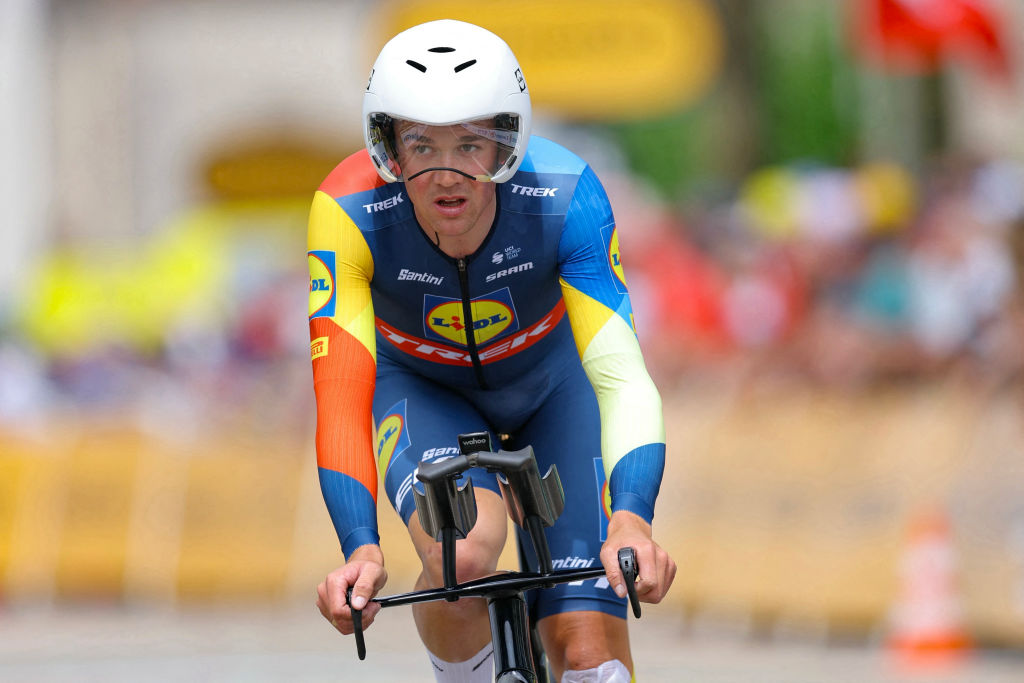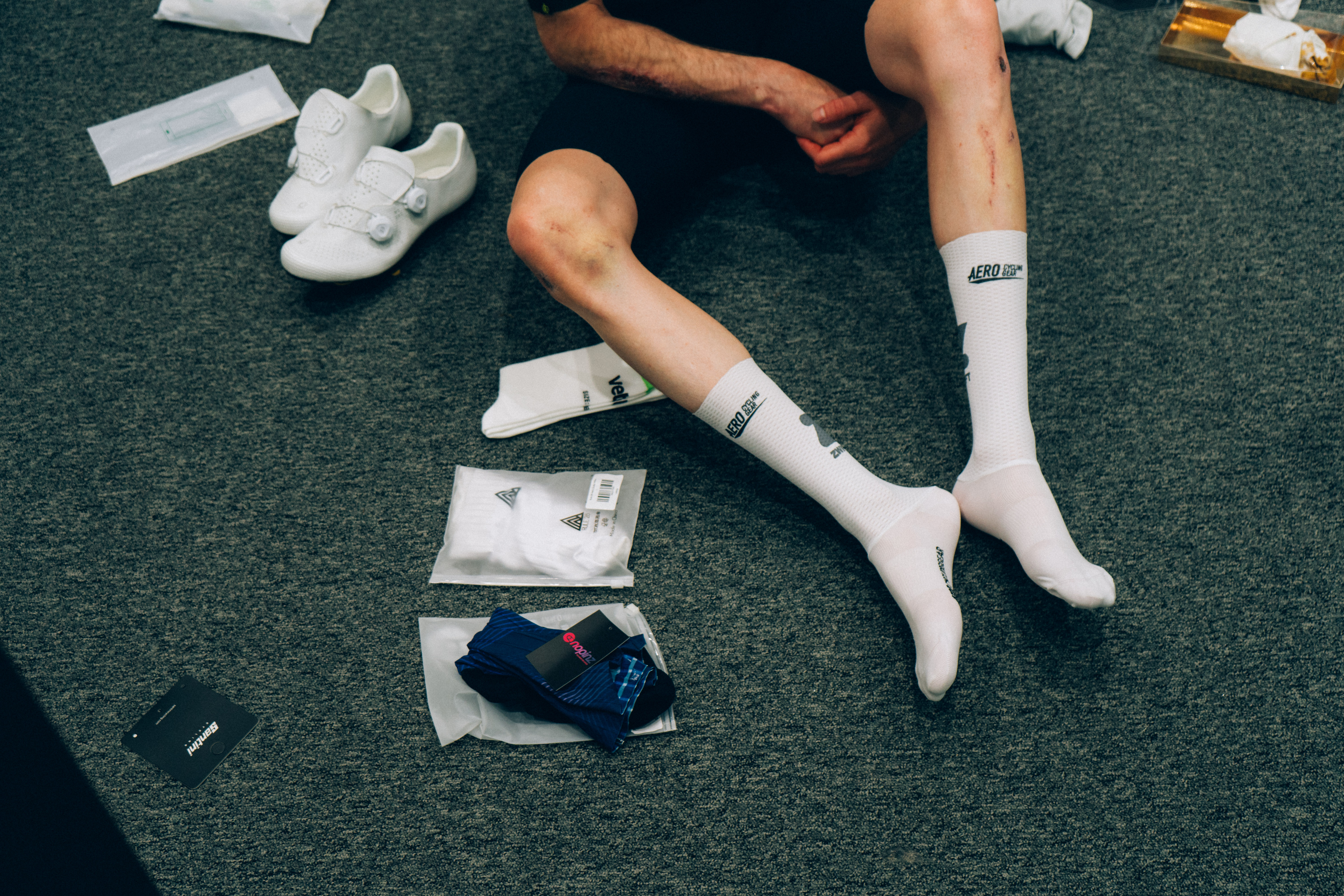Giro d'Italia 2025 route
13 mountain stages from May 9 to June 1 for 108th edition of the Giro d'Italia
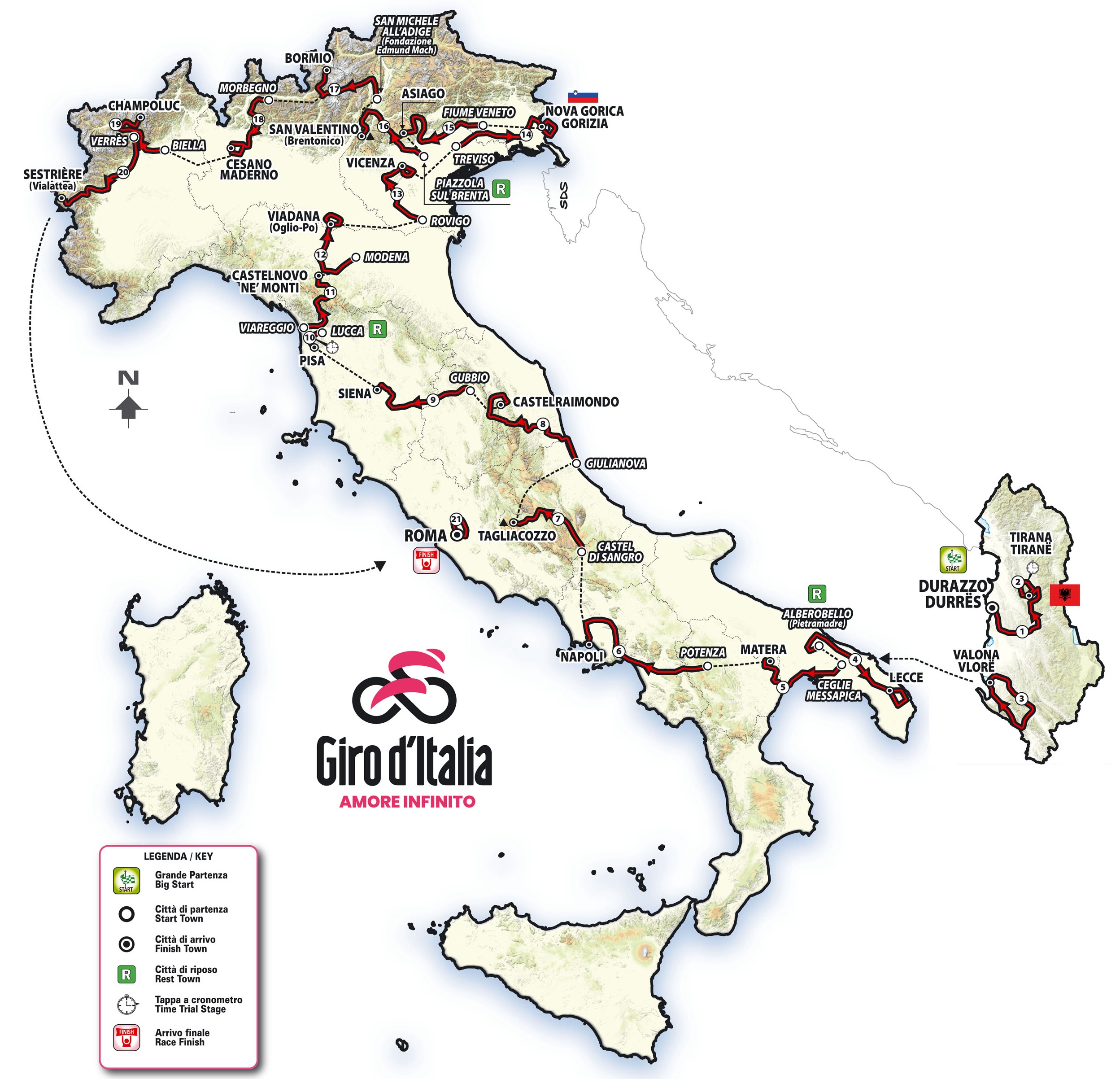
The 2025 Giro d'Italia appears to have it all, with a testing international start in Albania, 42.3km of time trailing, six sprint stages, a terrible final week in the mountains, 30km of strade bianche gravel roads and even the gravel roads of the Colle delle Finestre climb in the Alps before a long transfer to Rome for the final stage.
This year's Corsa Rosa is the 108th edition of the race, with the 21 stages held between Friday, May 9 and Sunday, June 1. The race starts on a Friday to allow three stages in Albania as part of the Grande Partenza and then an early rest day or transfer day on Monday, May 12. The total race distance is 3,413km, with an average stage distance of 162.5km.
In 2024 Giro d'Italia race director Mauro Vegni cut the total metres of altitude by 20% to 44,650, perhaps to favour Tadej Pogačar's (UAE Team Emirates) Giro-Tour double attempt. This year there are many more mountains to climb during the 21 stages in May, with eight medium mountain stages and five mountain stages.
There are five mountain finishes, with tough climbs in the south of Italy and the steep San Pellegrino in Alpe in the Tuscan Apennines. Stage 15 includes the Montegrappa climb, stage 16 includes five climbs to the west of Lake Garda, while stage 17 finishes in Bormio after climbing the Mortirolo.
The final winner of the maglia rosa will be decided in the Alps, with over 9,000 metres of climbing in two days. Stage 19 is packed with four major climbs in 166km and then stage 20 climbs the mighty Colle delle Finestre, where Chris Froome attacked solo to snatch victory from Tom Dumoulin.
Total distance: 3,413 kilometres
Total altitude gain: 44,650. metres
Average stage distance: 162.5 kilometres
Total mountain finishes: 5
The presentation of the 2025 route of the Giro was delayed until January but teams were apparently given details of the route so they could decide which riders will take the Corsa Rosa in May.
Albanian Prime Minister Edi Rama, several Italian politicians and former winners Ivan Basso and Alberto Contador attended the presentation in Rome's Auditorium della Musica, as did Giro d'Italia Women winner Elisa Longo Borghini and 2024 men's best young rider Antonio Tiberi.
Details of the route of the Giro d'Italia Women can be found on the separate race page.
Pogačar will almost certainly not defend his 2024 victory but 2023 winner Primož Roglič (Red Bull-Bora-Hansgrohe) has confirmed his return. Juan Ayuso is expected to lead UAE Team Emirates with Adam Yates and Isaac del Toro. Wout van Aert, Simon Yates and sprinter Olav Kooij will lead Visma-Lease a Bike. Nairo Quintana (Movistar), Mikel Landa leads Soudal-QuickStep, Richard Carapaz is expected to lead EF Education-Easypost, while Romain Bardet (Picnic PostNL) has opted to end his Grand Tour at the Giro.
Several teams are hoping to secure the final three wild card invitations alongside the 18 WorldTour teams and Israel-Premier Tech, including Team Polti VisitMalta, VF Group-Bardiani CSF-Faizanè, Tudor Pro Cycling and Q36.5. Tudor watches are again the Giro and RCS Sport 'timing sponsor' and that should ensure them a place.
Stage 1: Durazzo - Tirana (164km)
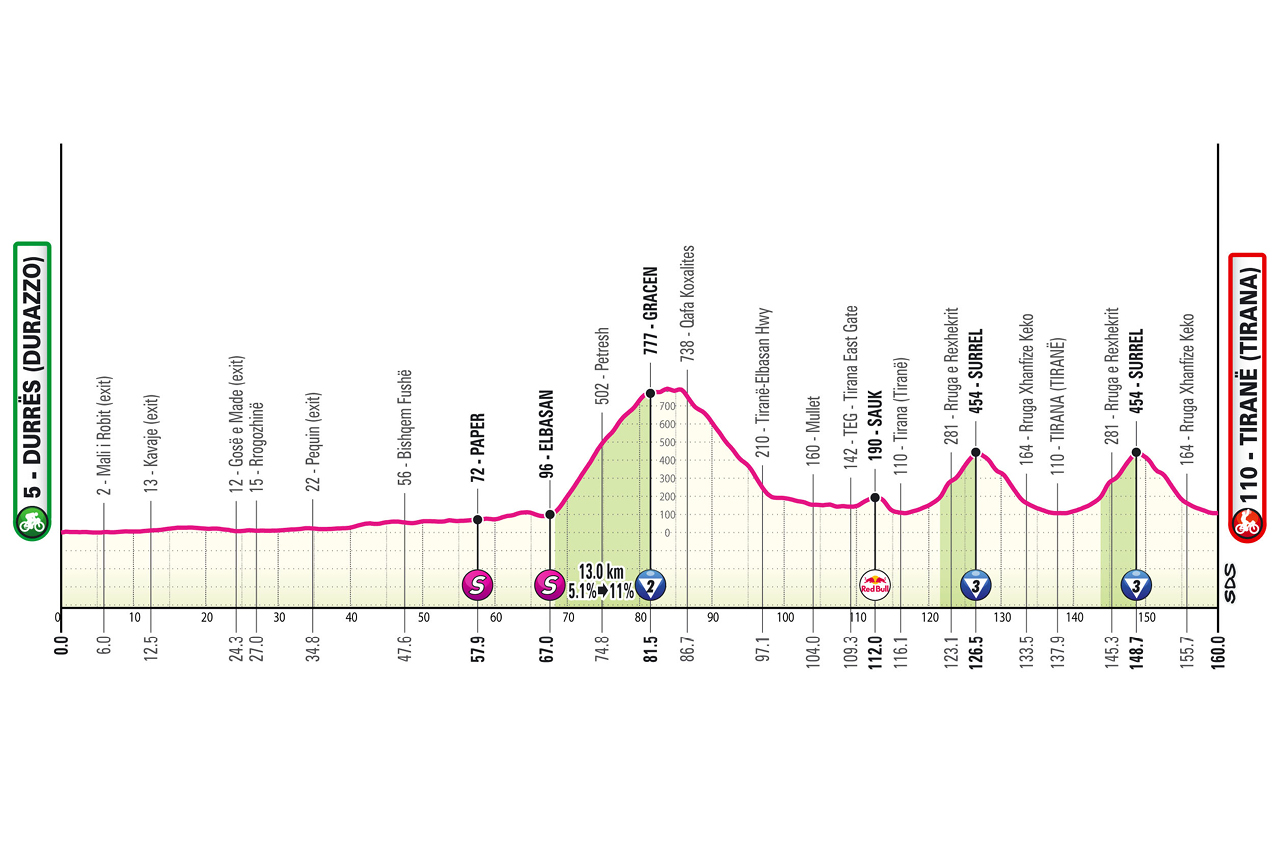
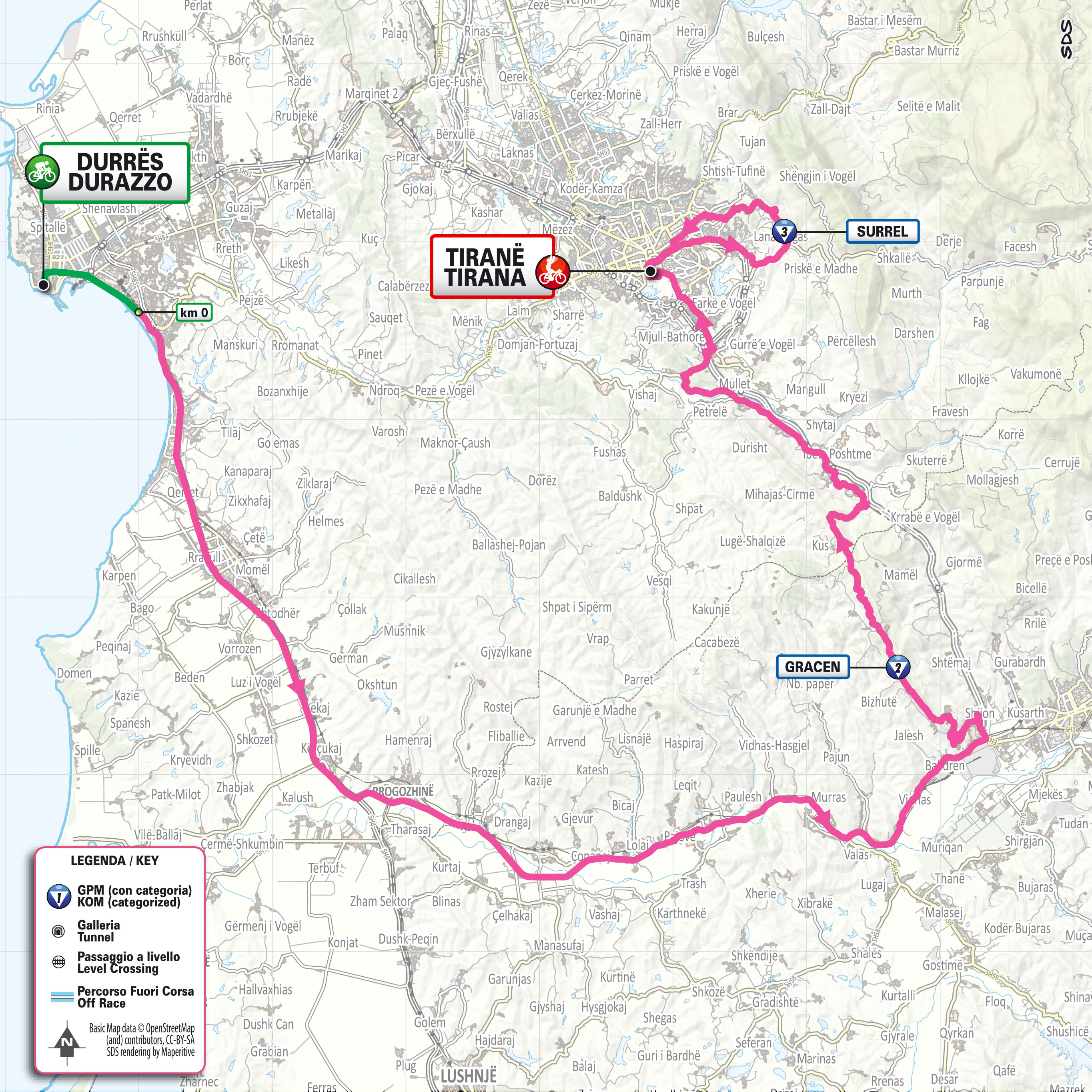
The start across the Adriatic sea in Albania is the 15th start outside of Italy. The two countries have strengthened relations in recent years after a history of tension and mass immigration 30 years ago.
The 2025 Giro will begin with a rolling 164km stage from Durazzo (Durrës) that will test the form and ambitions of the sprinters, but appears to perfectly suit Wout van Aert and his fast-finishing cohorts.
The opening day of racing in Albania begins from the coastal city of Durazzo, with varied terrain leading inland to Tirana. Once across the Gracen pass, riders will tackle a 22.2km circuit twice that features an ascent of Surrel with gradients in the double digits. The second time across the Surrel climb will ignite attacks for a final 12km to the finish in the city centre.
2025 Giro d'Italia stage 1 details
Stage 2: Tirana - Tirana, ITT (13.7km)
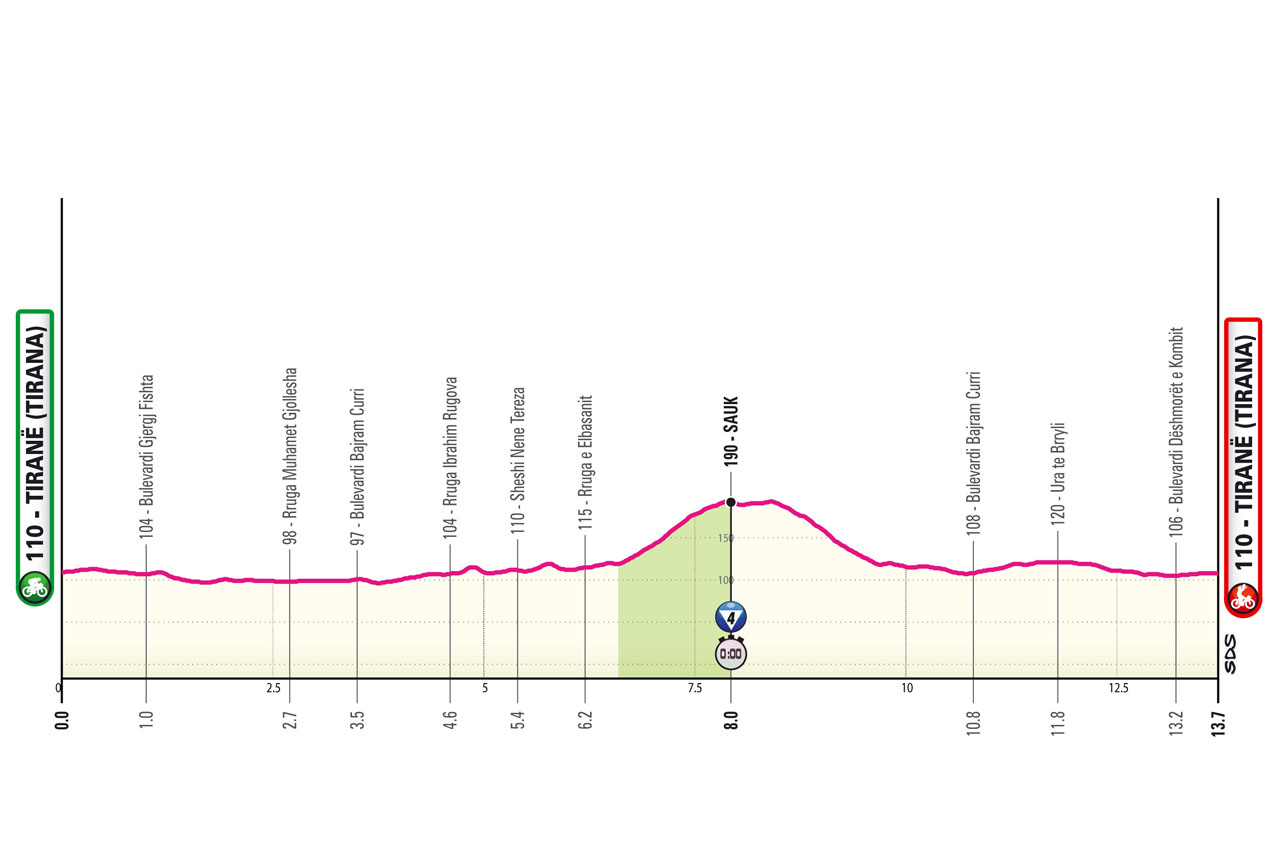
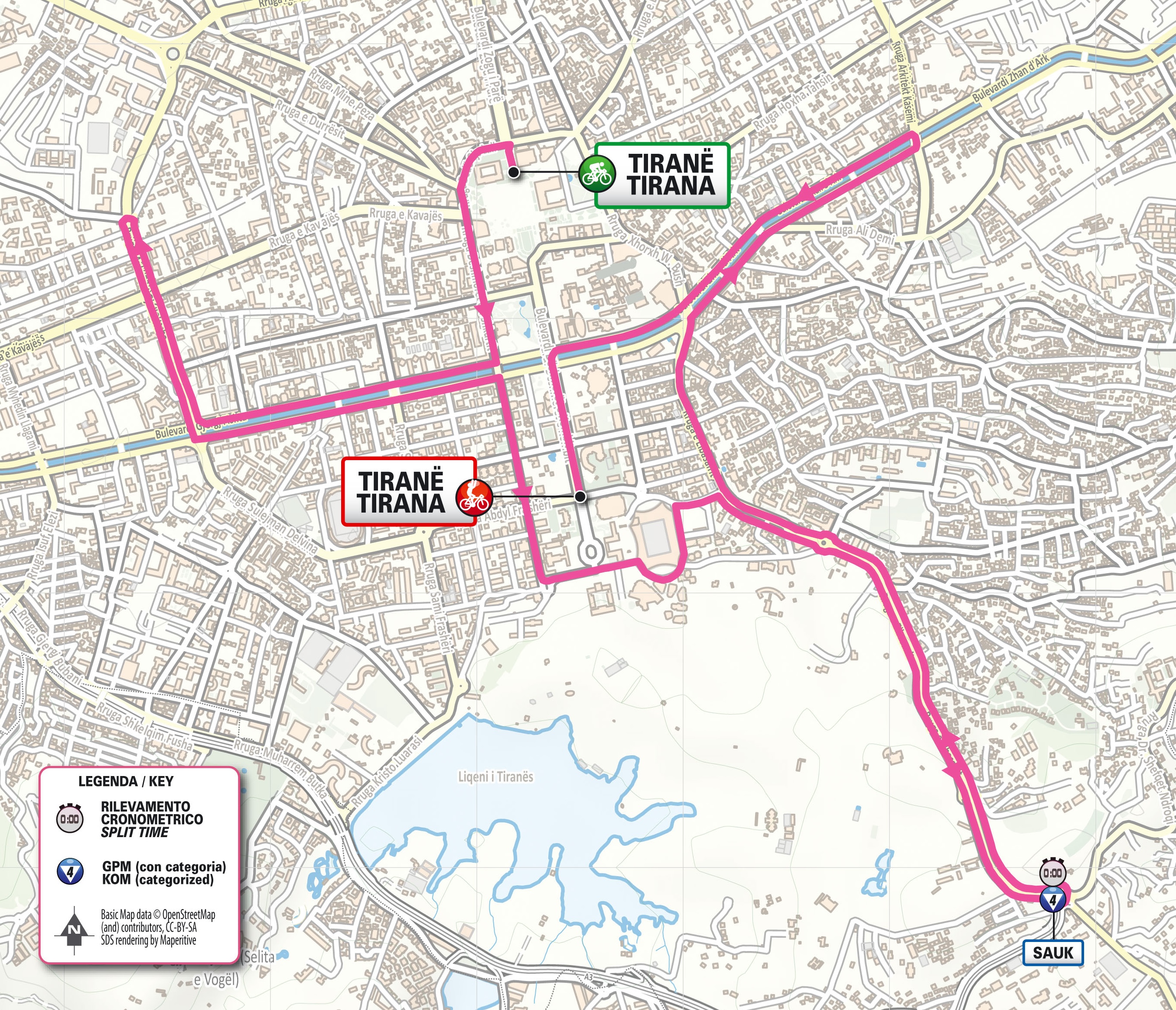
Stage 2 is a 13.7km individual time trial around Tirana and so will be an early test for the GC contenders. The course includes the Sauk climb at the halfway point, which rises 1.5km, with three U-turns and a few other sharp corners along the 13.7km route.
Before the finish in the city centre, there is one climb, a category 4 rise across 1.5km to Sauk. Riders will descend on the same slope for the second half of the race against the clock, banks of the Lanë river signalling a final left-hand turn to the finish.
2025 Giro d'Italia stage 2 details
Stage 3: Valona - Valona (160km)
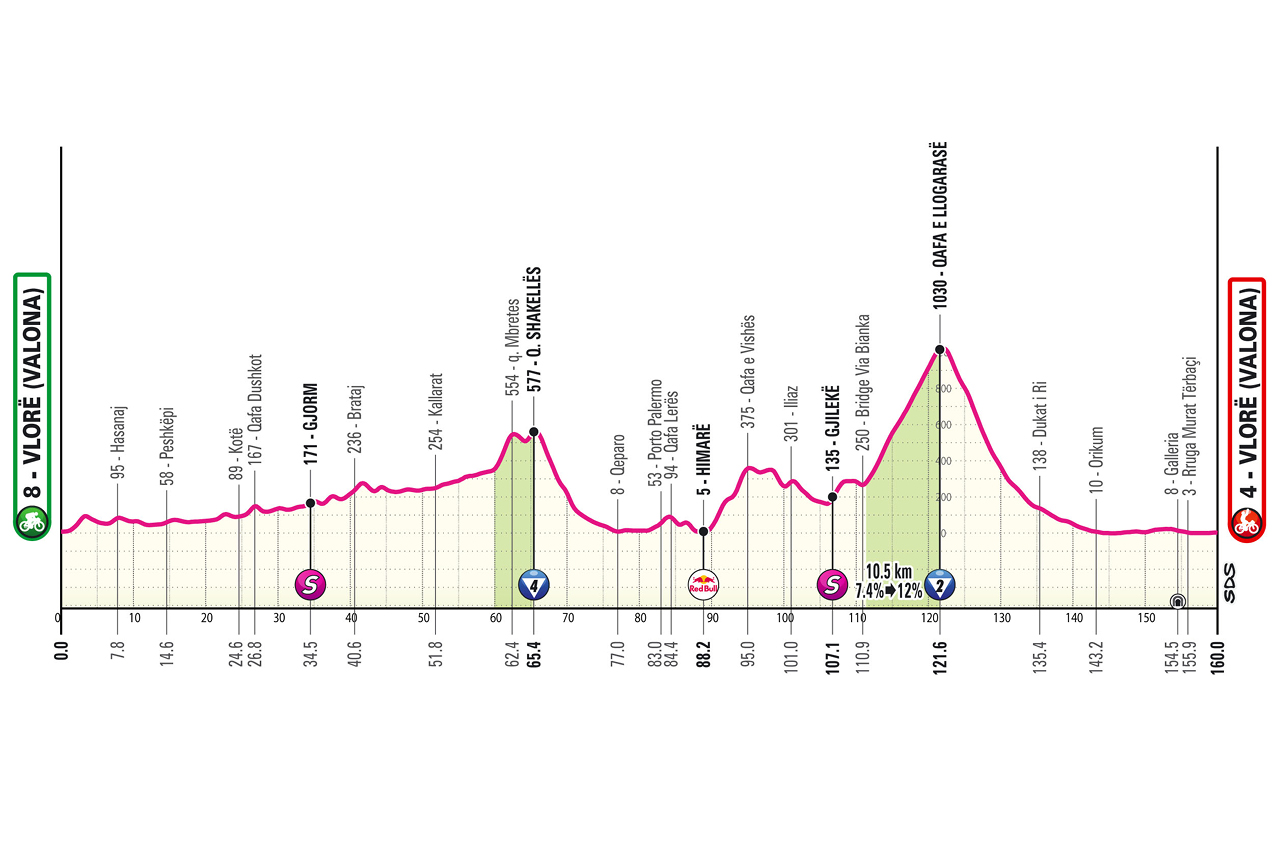
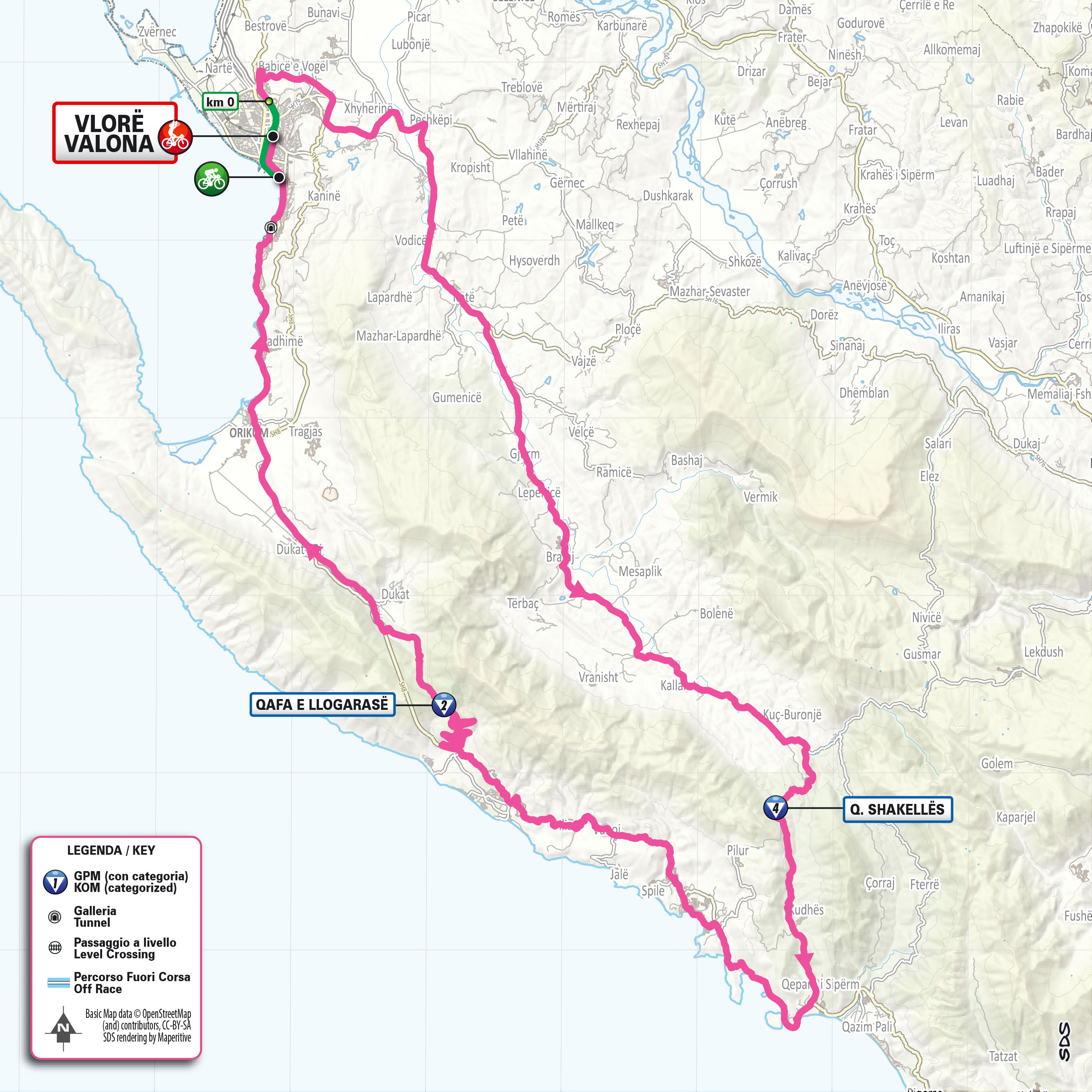
The third and final stage in Albania is a hilly 160km race around Vlorë in the south of the country.
Most of the opening 65km is a constant uphill to a category 4 KOM. The middle section of the remaining 95km turns back to the north. The Qafa E Llogarasë climb (10.7km at 7.4%) will be tackled 39km from the finish, with a flat last 25km giving any chasers a chance to close any gaps.
2025 Giro d'Italia stage 3 details
Stage 4: Alberobello (Pietramadre) - Lecce (187km)

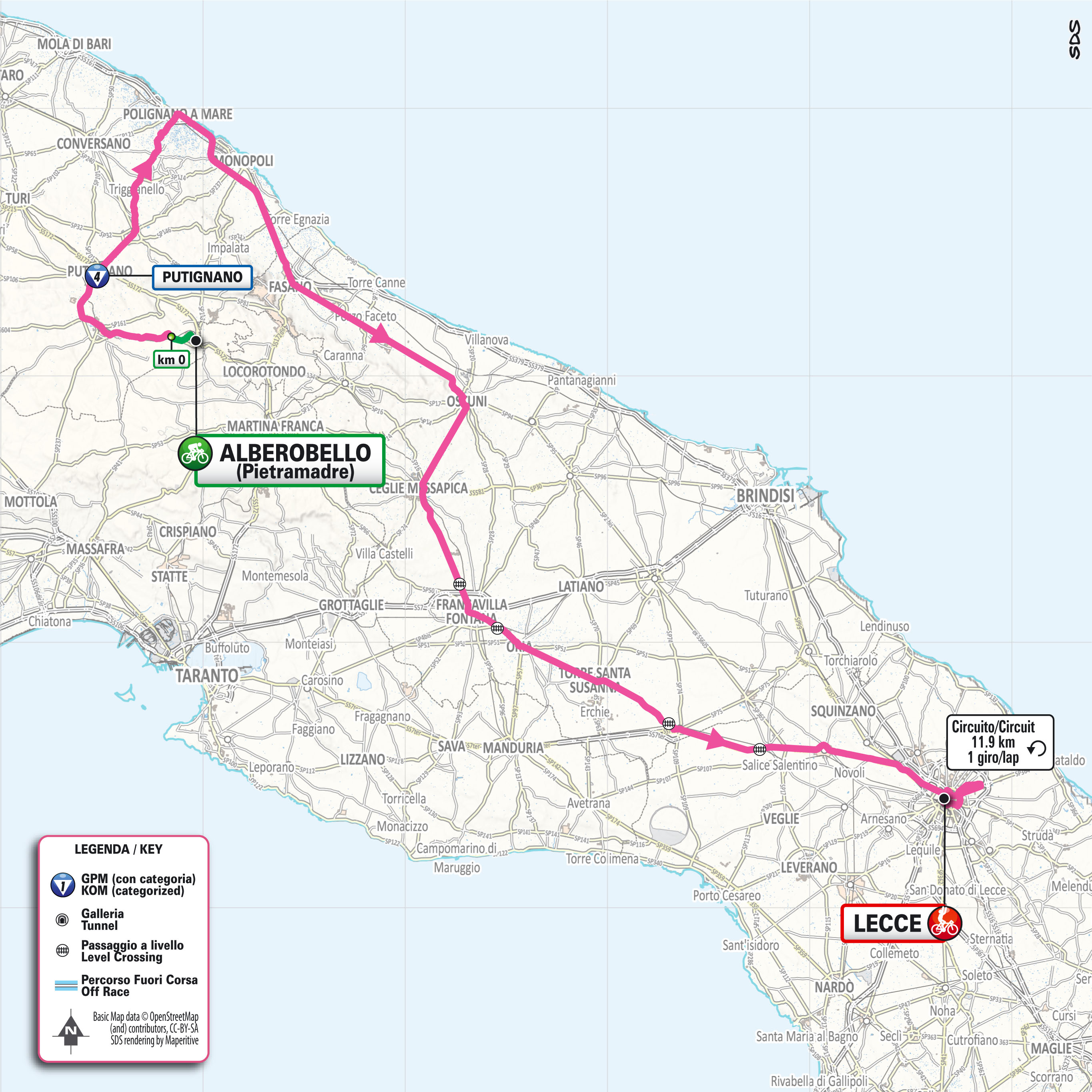
Following a transfer from Albania to Puglia in the south of Italy and an early rest day on Monday, action resumes on May 13 with stage 4 from Alberobello to Lecce.
The riders and race caravan will transfer to Puglia in the south of Italy on Sunday night and Monday by plane and boat, and start stage 4 in Alberobello for a 187 kilometre stage to Lecce on Tuesday, May 13.
2025 Giro d'Italia stage 4 details
Stage 5: Ceglie Messapica - Matra (145km)
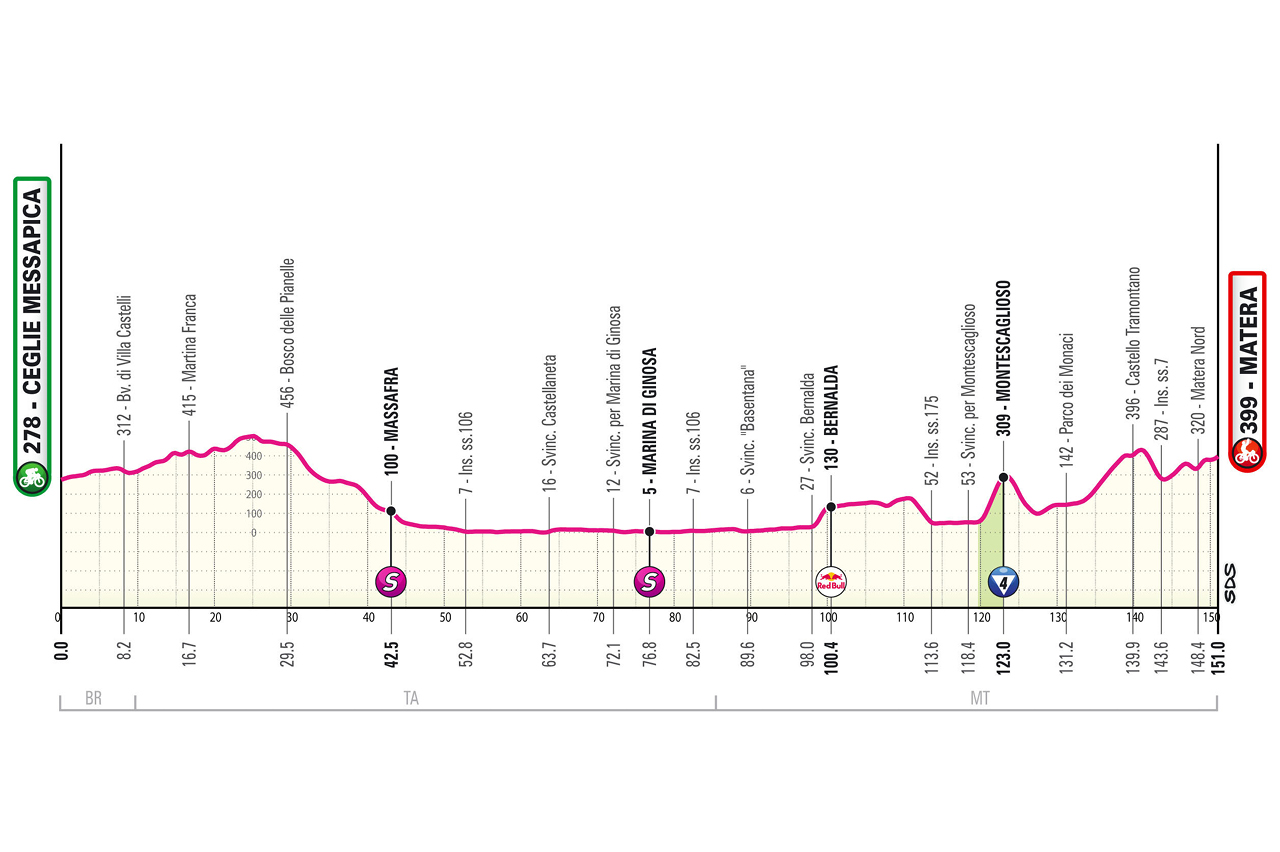
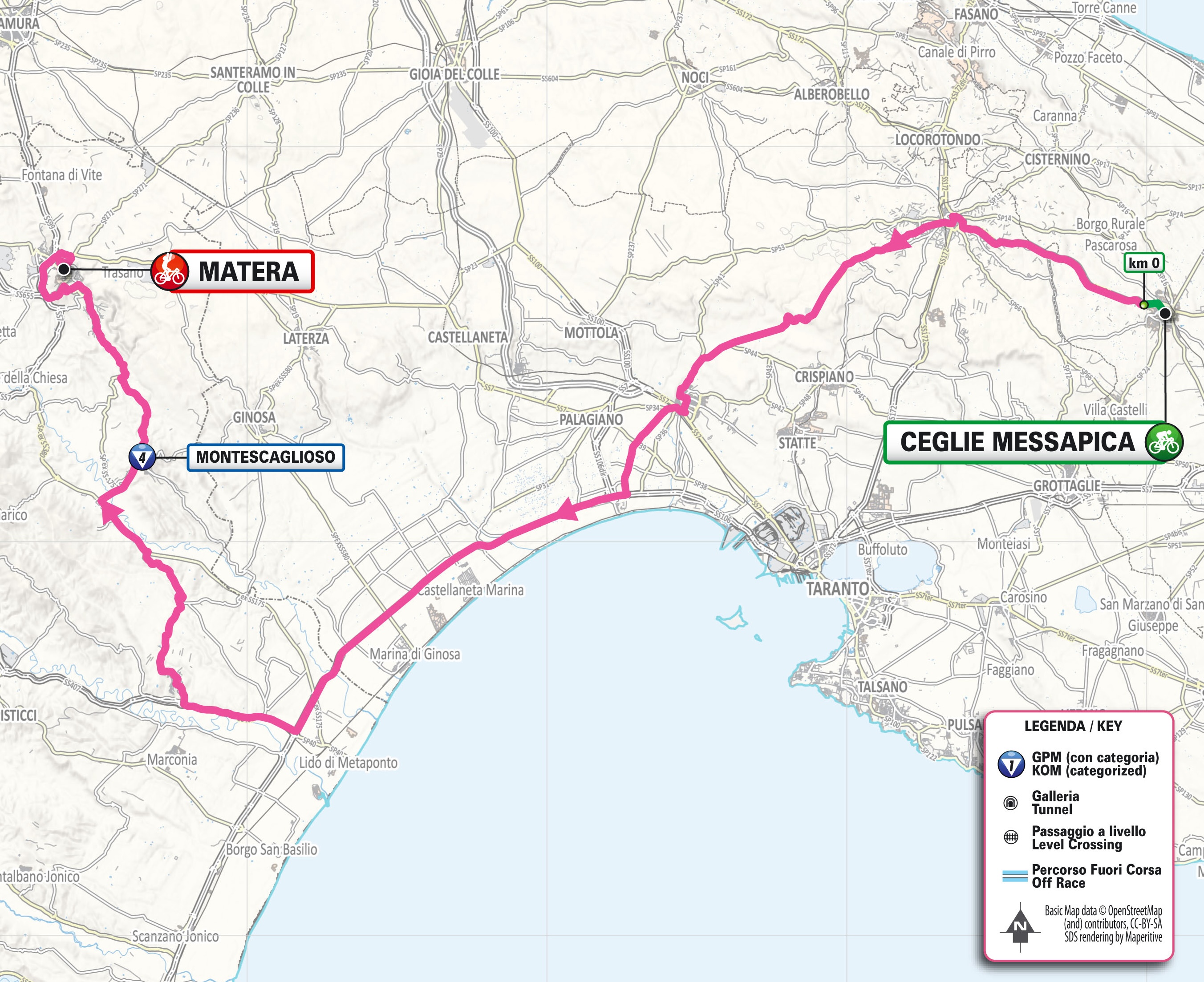
Another flat day comes on stage 5, with a 144km route starting in Ceglie Messapica with the middle section along the Metaponto coast. Once riders make sharp turn inland at Lido di Metaponto, a category 4 ascent to Montescaglioso must be crested and then 25 rolling kilometres more to the finish in Matera.
2025 Giro d'Italia stage 5 details
Stage 6: Potenza - Napoli (226km)
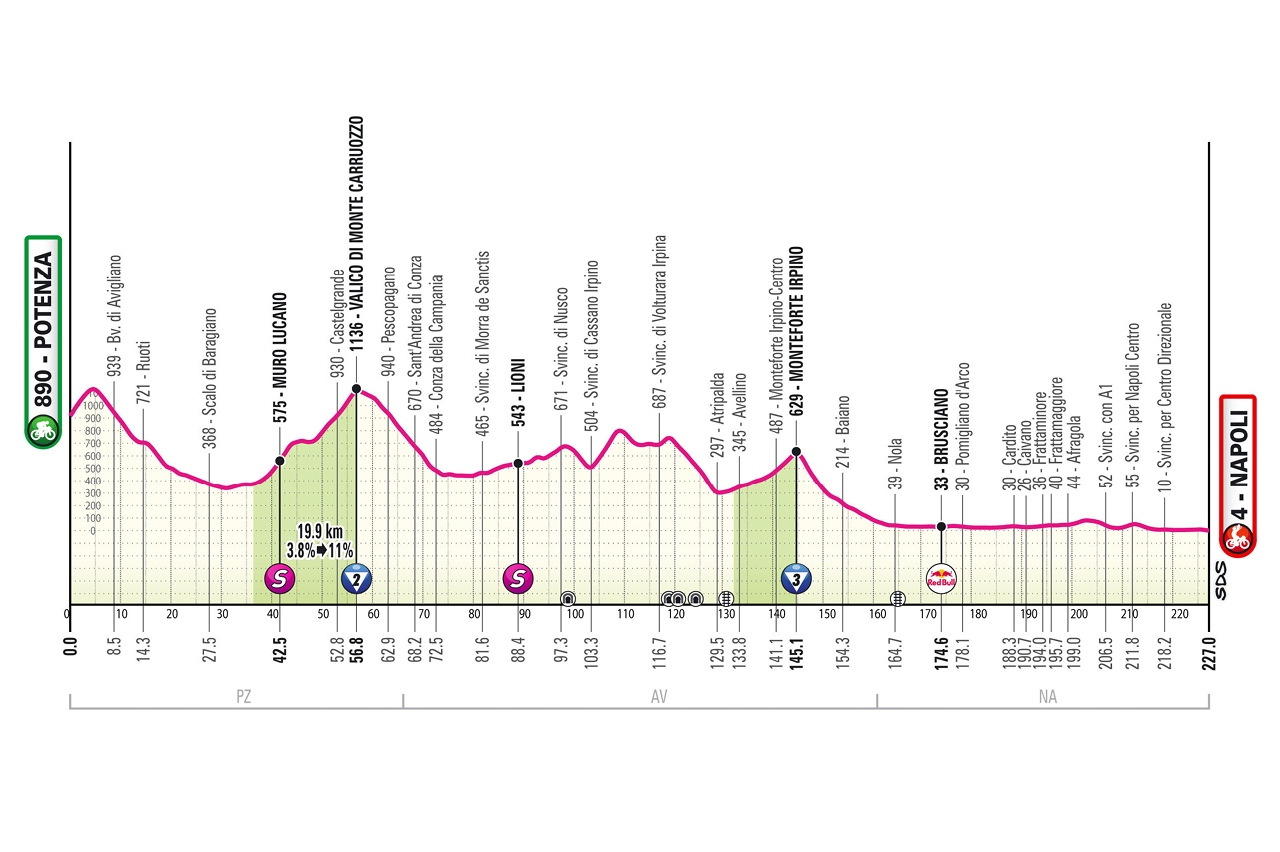

Stage 6 is long at 226km and is hilly early on before a late climb overlooking the Bay of Naples. The stage begins in Potenza in the Basilicata and heads northwest, taking on two KOMs on the route before unleashing sprinters for the finish in Naples.
The first KOM hits at kilometre 40 and is a long, 19.9km climb to Valco di Monte Carruozzo, with gradients that reach 11%. There is a rolling 50km to the second KOM, a manageable category 3 at Monteforte Irpino, with the path to Naples going north of Mount Vesuvius.
2025 Giro d'Italia stage 6 details
Stage 7: Castl di Sangro - Tagliacozzo (168km)
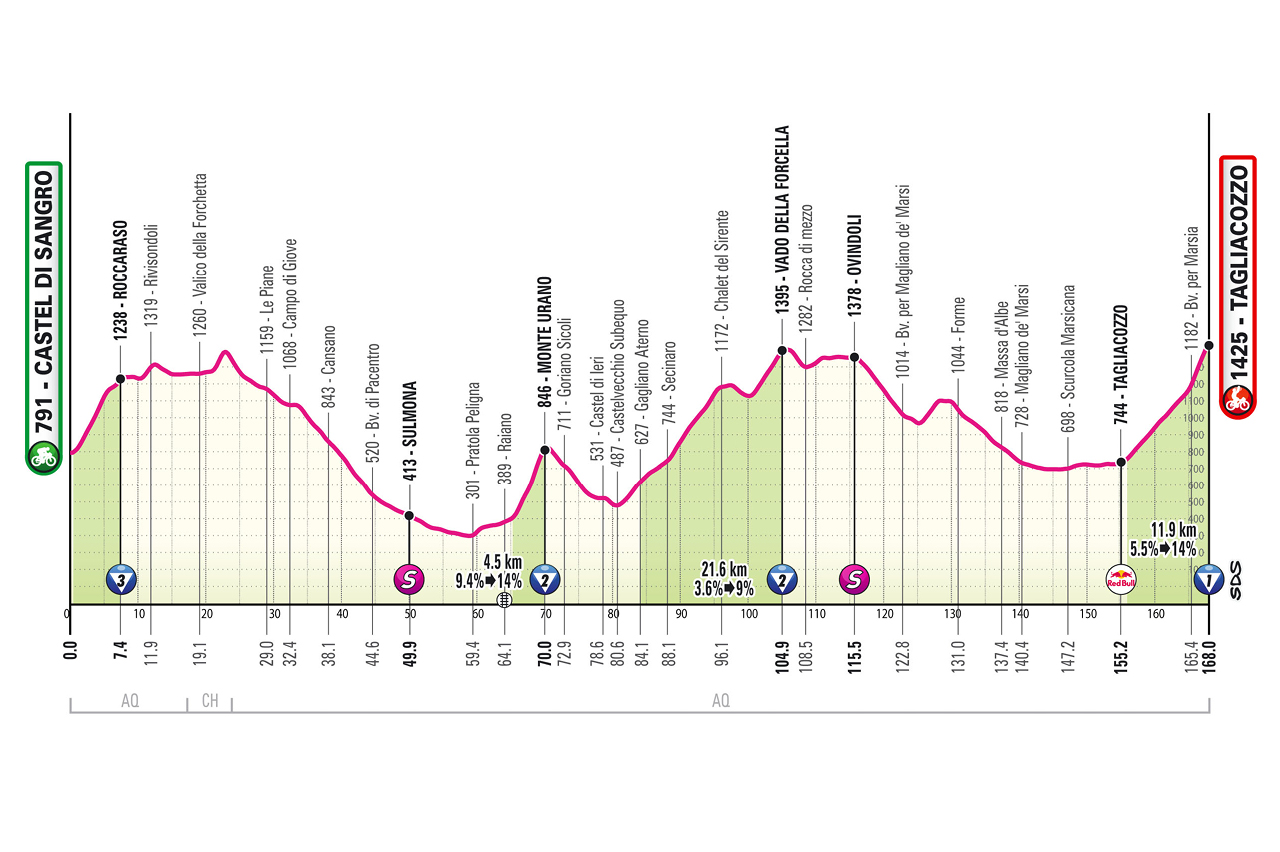
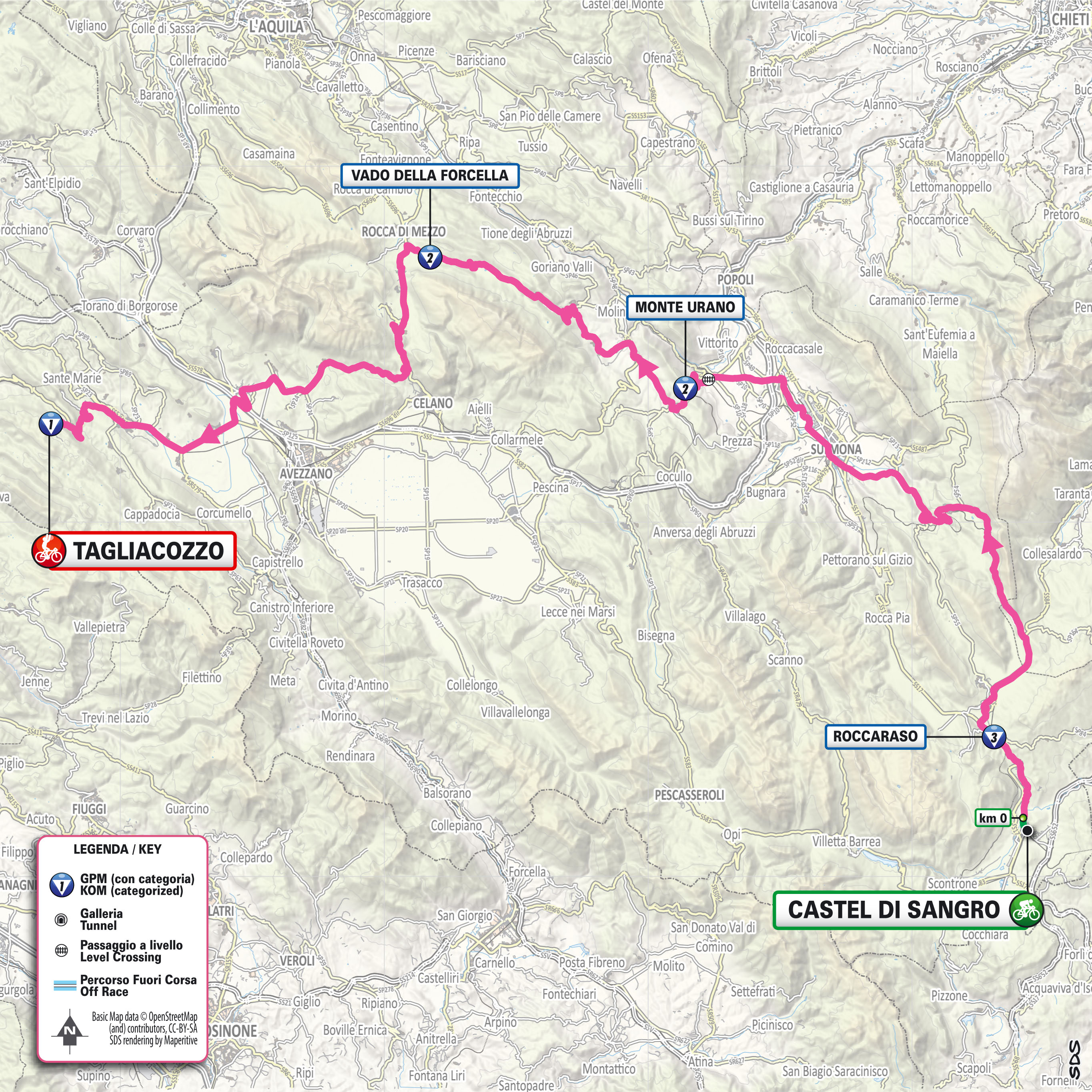
The first summit finish of the 2025 Giro d'Italia awaits on stage 7 as the riders enter the Apennines. The 168km route begins in Castel di Sangro with an immediate ascent of 7.4km to Roccaraso, then rockets down the next 54km for the ascent of category 2 Monte Urano (4.5km, maximum 14%).
The transition to the penultimate climb of the day is short, just 14km, The Vado della Forcella must scaled across 21.6km, with one false flat and a maximum of 9%. The route rolls through a flat valley before hitting the final ascent from Tagliacozzo to Marsia, with the last 3km of the 12.6km climb featuring persistent double-digit gradients.
2025 Giro d'Italia stage 7 details
Stage 8: Giulianova - Castelraimondo (197km)

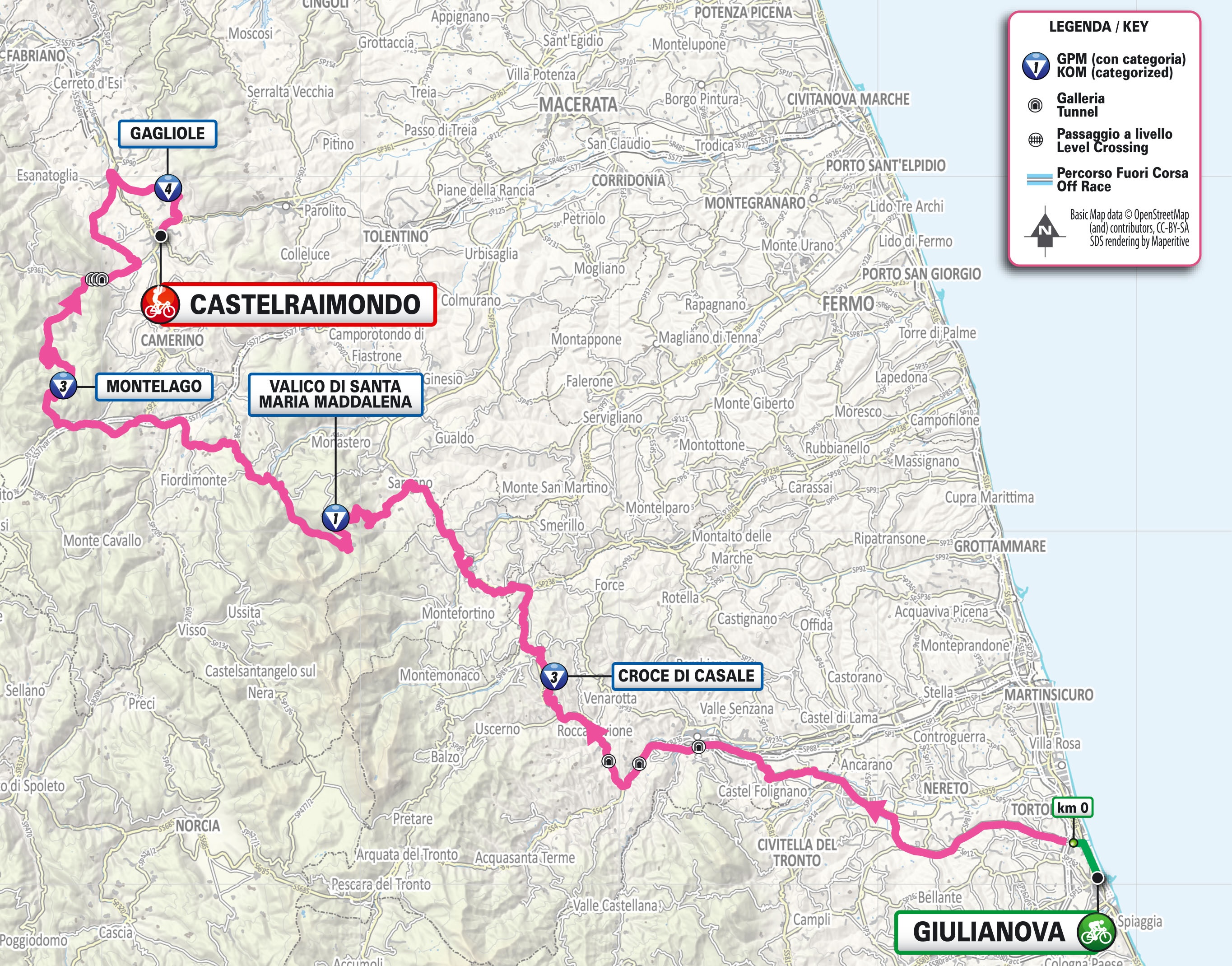
Stage 8 is close to 200km and includes the steep 'muri' climbs of Le Marche, often raced during Tirreno-Adriatico.
The stage starts in Giulianova with 3,700 metres of elevation gain, using the steep climbs of often raced during Tirreno-Adriatico. It includes a sequence of 'muri' including the Santa Maria Maddalena, Montelago, Castel Santa Maria (uncategorised climb) and Gagliole.
There are a total of four categories climbs on the day, the first one after the opening 53km at Croce di Casale. From the final KOM at Gagliole, it's a swift 6.5km to the finish in Castelraimondo.
2025 Giro d'Italia stage 8 details
Stage 9: Gubbio - Siena (181km)
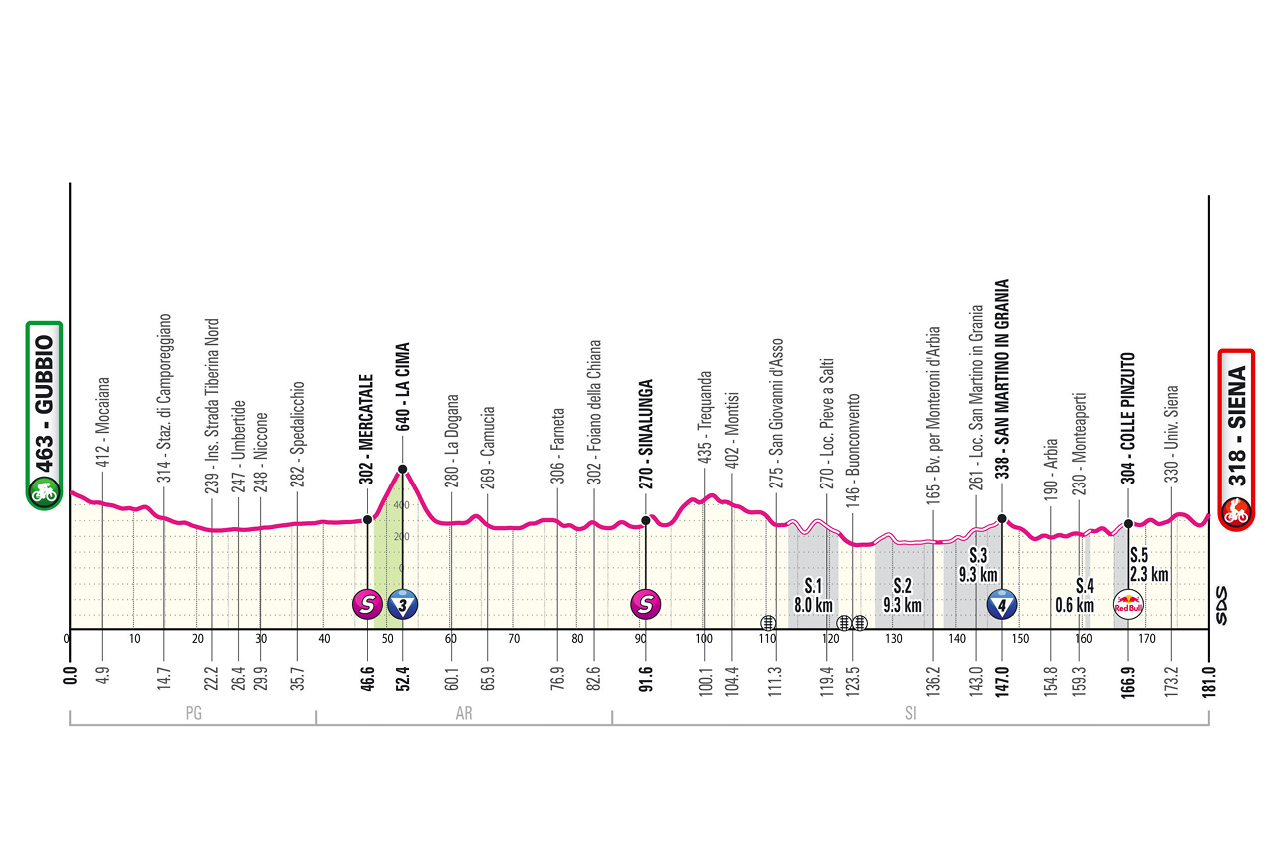
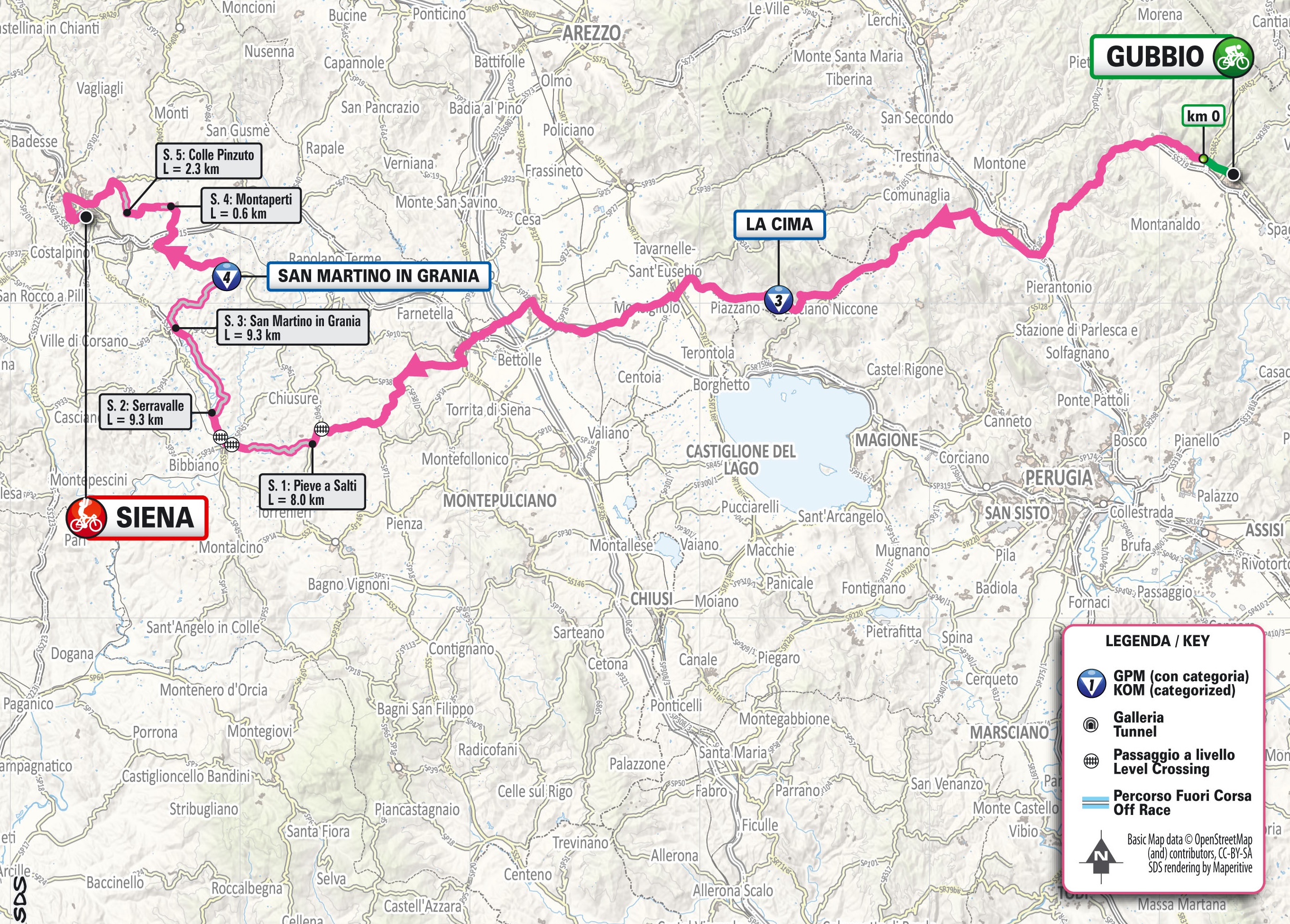
Stage 9 from Gubbio to Siena includes five gravel sections across 30km made famous in Strade Bianche and the finish in Siena's Piazza del Campo. The 181km stage provides 46km before the first uphill challenge to La Cima, a 4km stiff climb that is a third category. Another 60km later, three long gravel sectors are crossed, the third one a 9.3km ascent to the KOM at San Martino in Grania. The final pair of gravel sectors are much shorter, but steep - Monteparti and Colle Pinzuti - which leave 13km remaining for the scamper up the Via Santa Caterina to the centre of Siena.
2025 Giro d'Italia stage 9 details
Stage 10: Lucca - Pisa (28.6km)
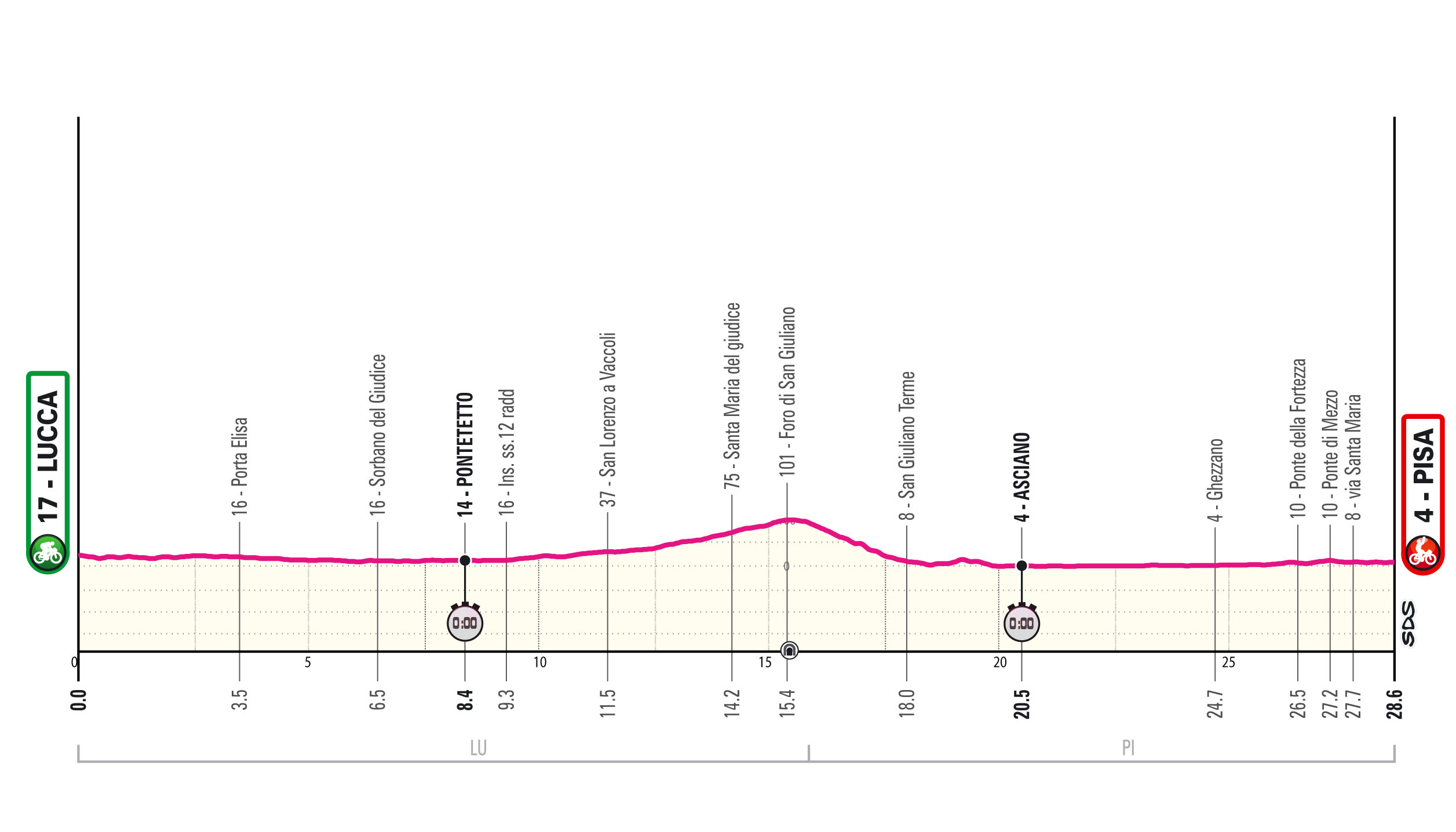
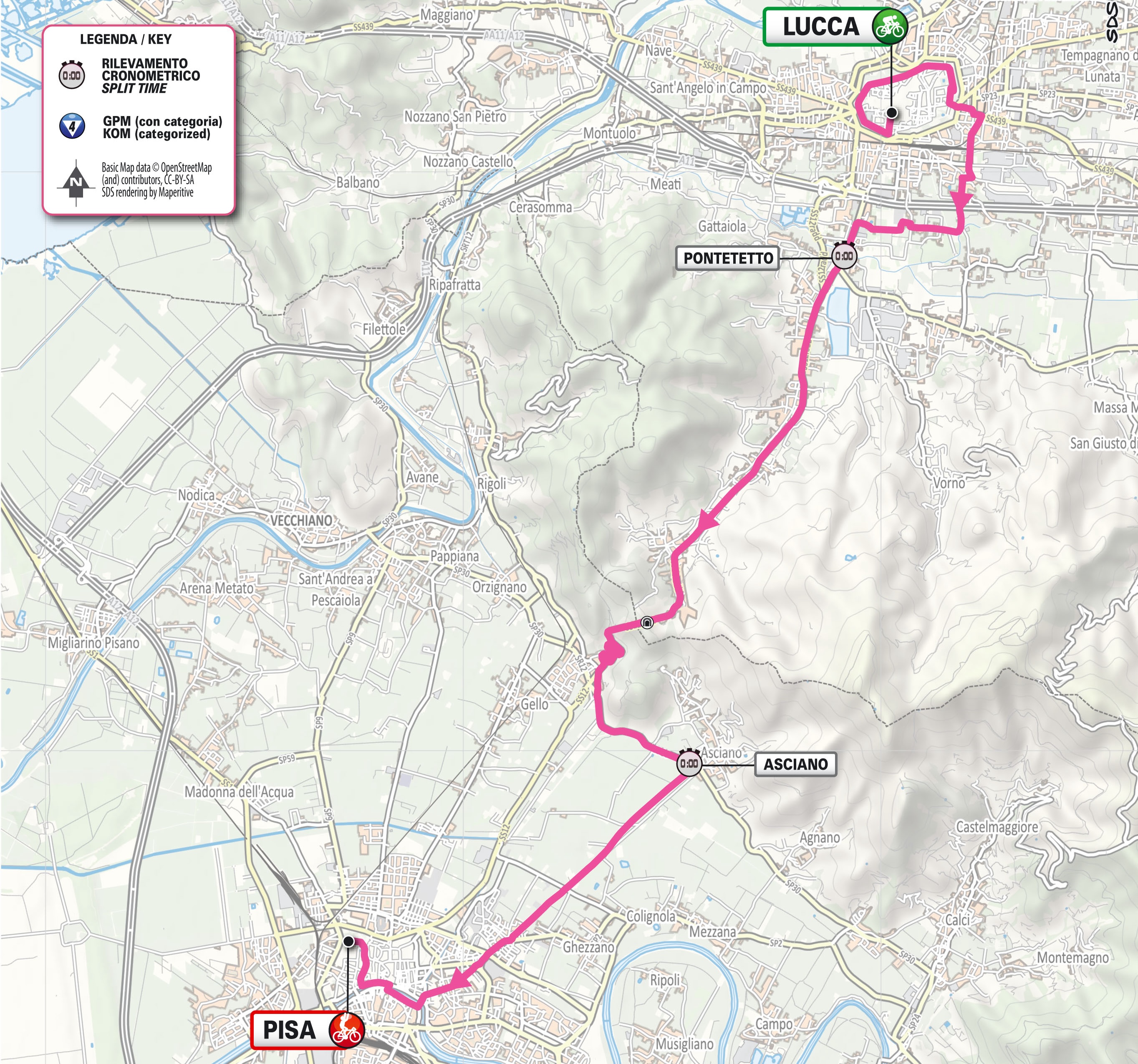
After a transfer from Siena to Lucca on Monday, May 19, the race resumes on the Tuscan coast for stage 10 for the second and final individual time trial of the Giro.
Riders embark on a relatively flat 28.6km race against the clock from Lucca, with one slow rise in the middle of the course. But the attention soon shifts to the back half of the course that follows the Medici aqueduct to reach the Arno river and a finish framed by the Leaning Tower of Pisa in the spectacular Piazza dei Miracoli. It is an homage to Knut Knudsen’s win back in 1977.
2025 Giro d'Italia stage 10 details
Stage 11: Viareggio - Castelnovo ne' Monti (185km)

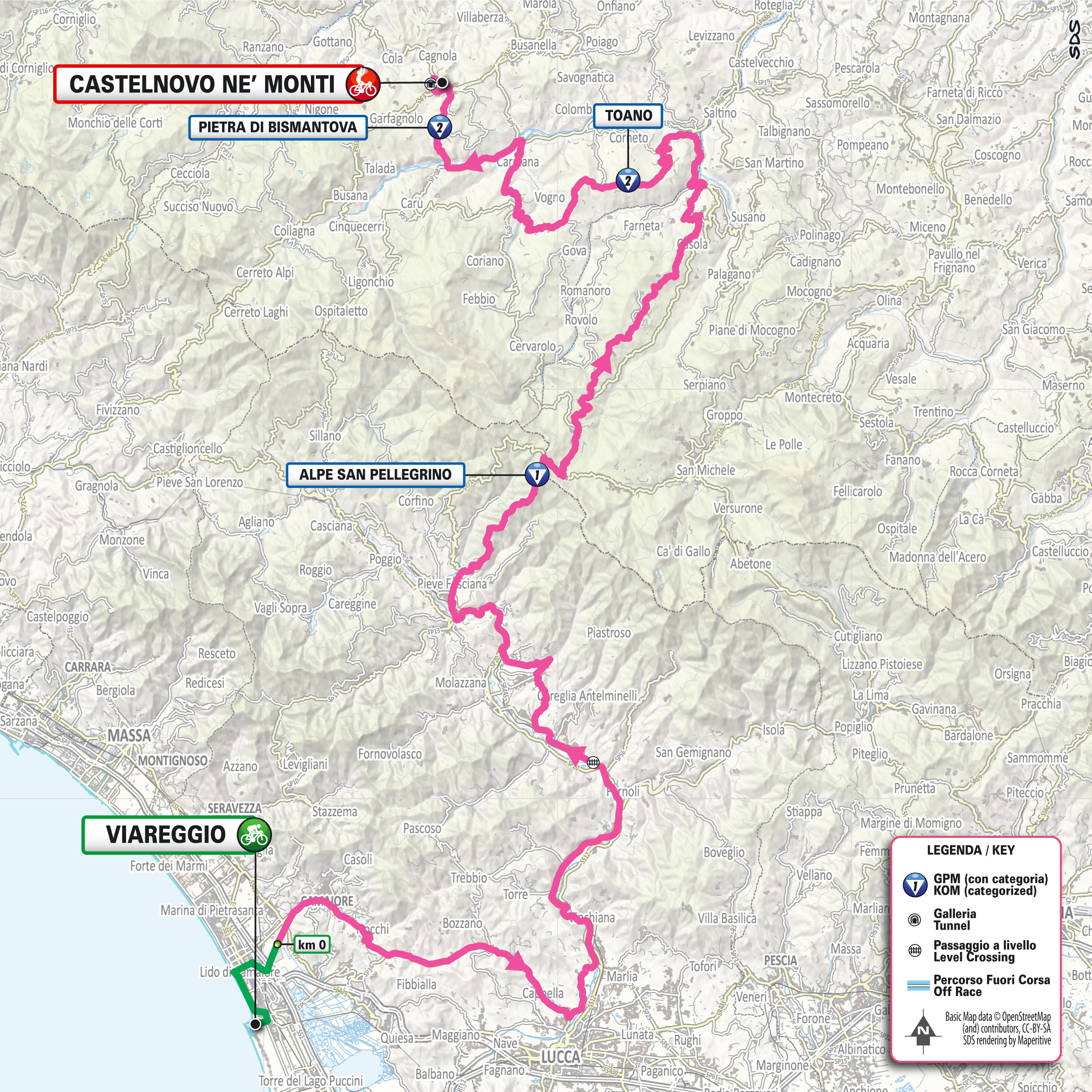
A mid-week contest in a return to the Apennines could shake up the general classification. From Viareggio the route begins at sea level and climbs to 1,397 metres in elevation in the opening 91km on the Alpe San Pellegrino, last raced 25 years ago in the Giro. The 9km climb brings gradients hitting 20%. A long, winding descent through the woods of the Apennines leads to a pair of category 2 climbs, first at Toano and then Pietra di Bismantova, for the final 10km to the finish at Castelnovo ne' Monti.
2025 Giro d'Italia stage 11 details
Stage 12: Modena - Viadana (172km)
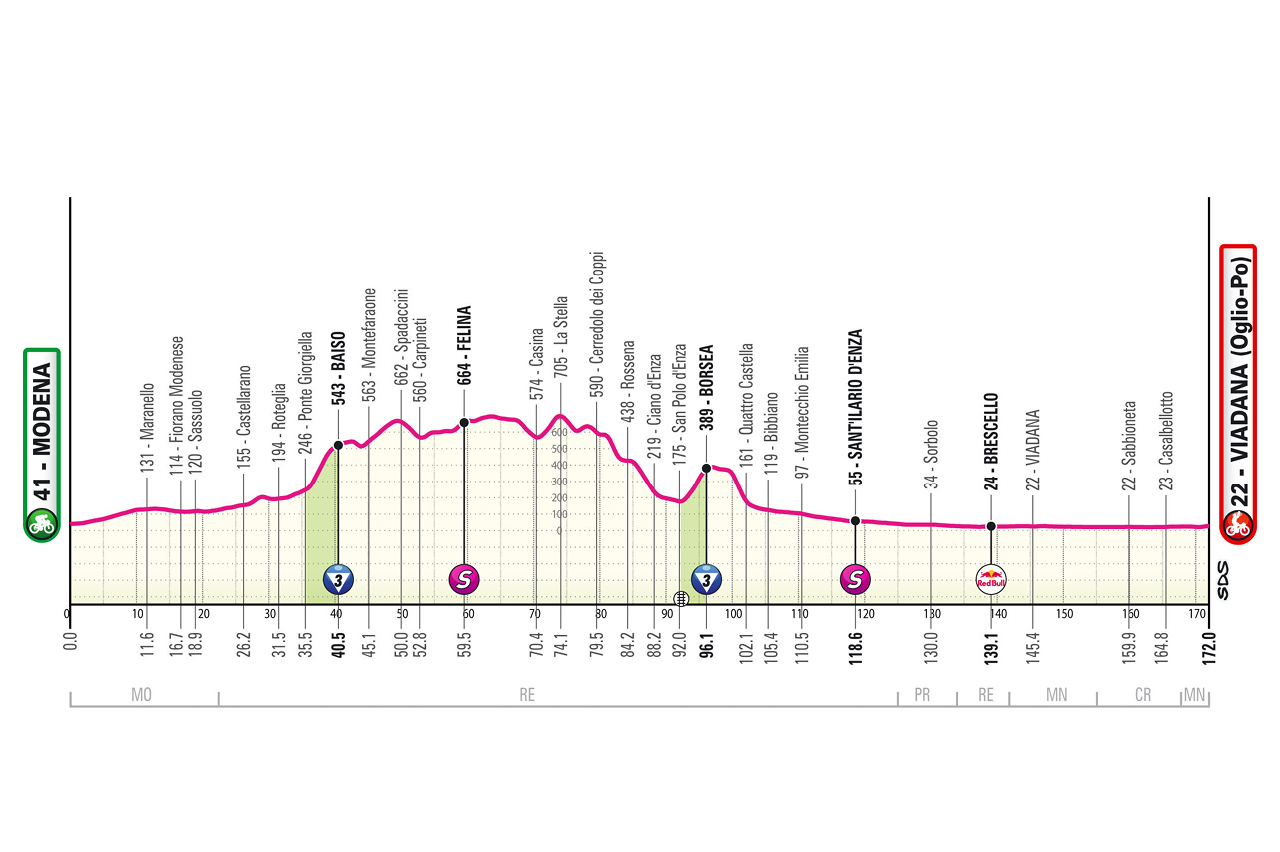
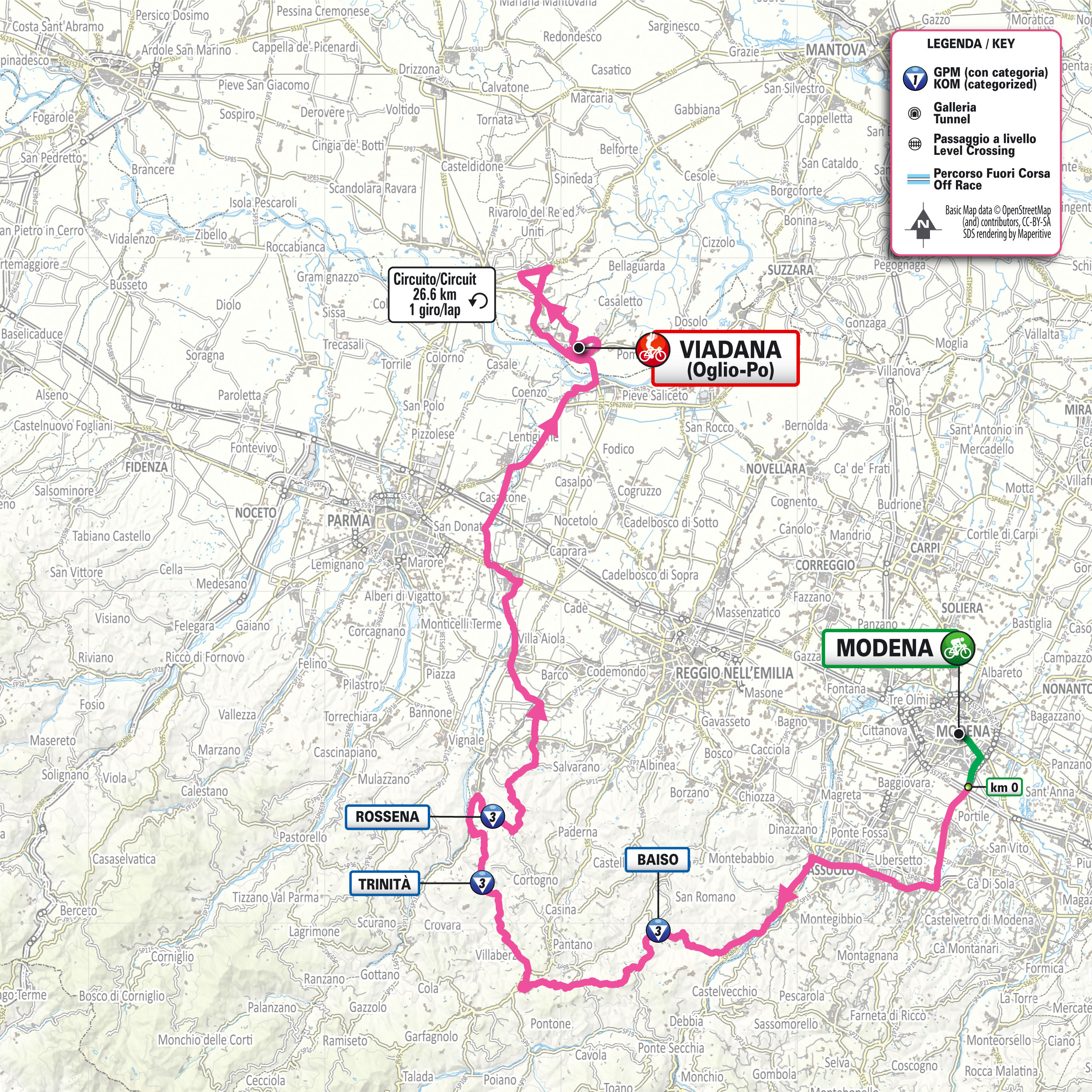
After a hard day of climbing, Thursday brings early hills from Modena and then the second half of the 172km route transitions to flat terrain in the Po Valley for a sprinter's battle in Viadana. After an initial passage through Viadana, the stage culminates with a 26.6km circuit touching the town of Sabbioneta.
2025 Giro d'Italia stage 12 details
Stage 13: Rovigo - Vicenza (180km)
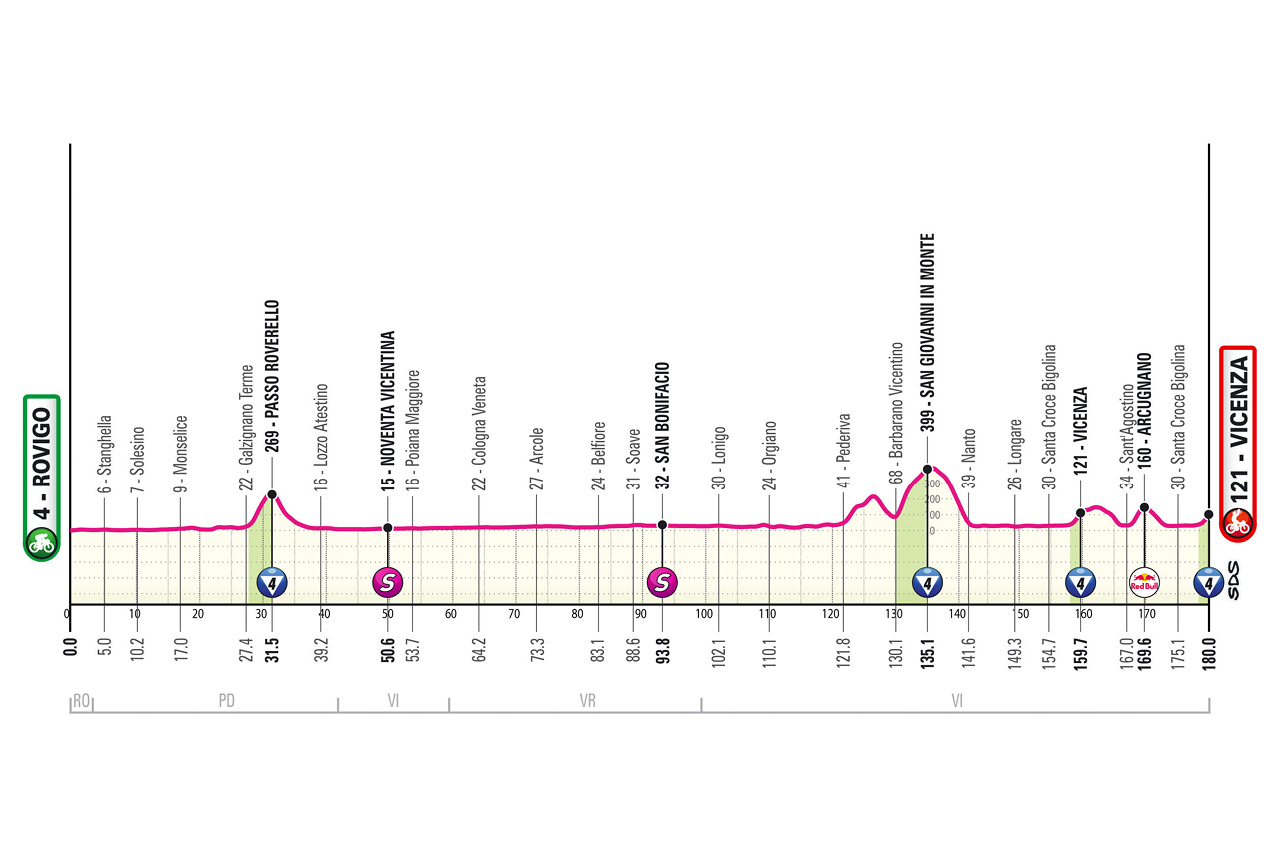
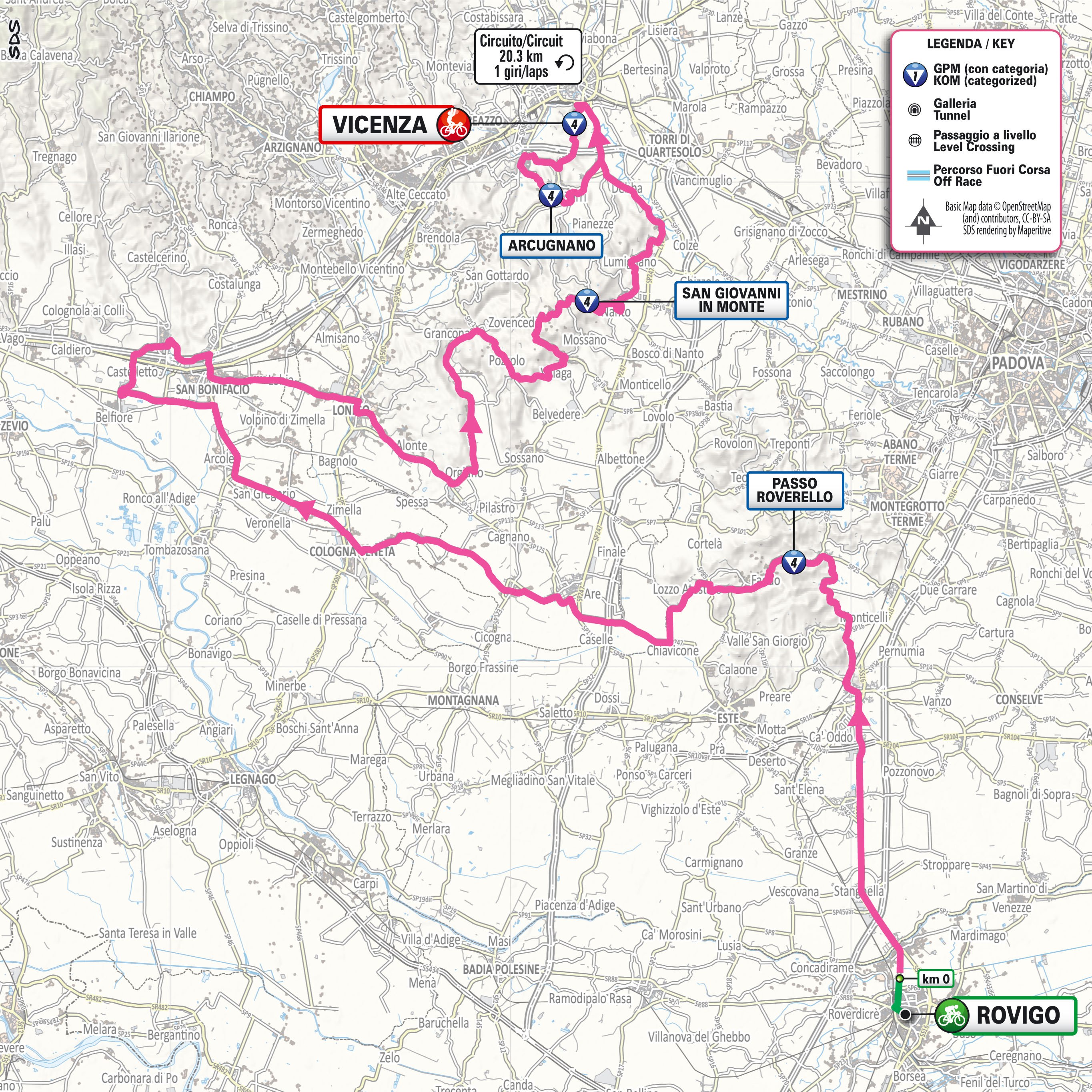
It's another day for the sprinters with 180km between Rovigo and Vicenza. This one is not straightforward, however, with a series of five category 4 ascents to force teams to focus on positioning. The first 4km climb, Passo Roverello, comes just 32km from the start. Flat terrain then continues for the next 90km to San Giovanni in Monte, a 5km pass. Once in Vicenza, after the first pass on Monte Berico, the riders will complete two laps of a 20.3km circuit featuring via Pilla and a second pass of Monte Berico.
2025 Giro d'Italia stage 13 details
Stage 14: Treviso - Nova Gorica/Gorizia (186km)
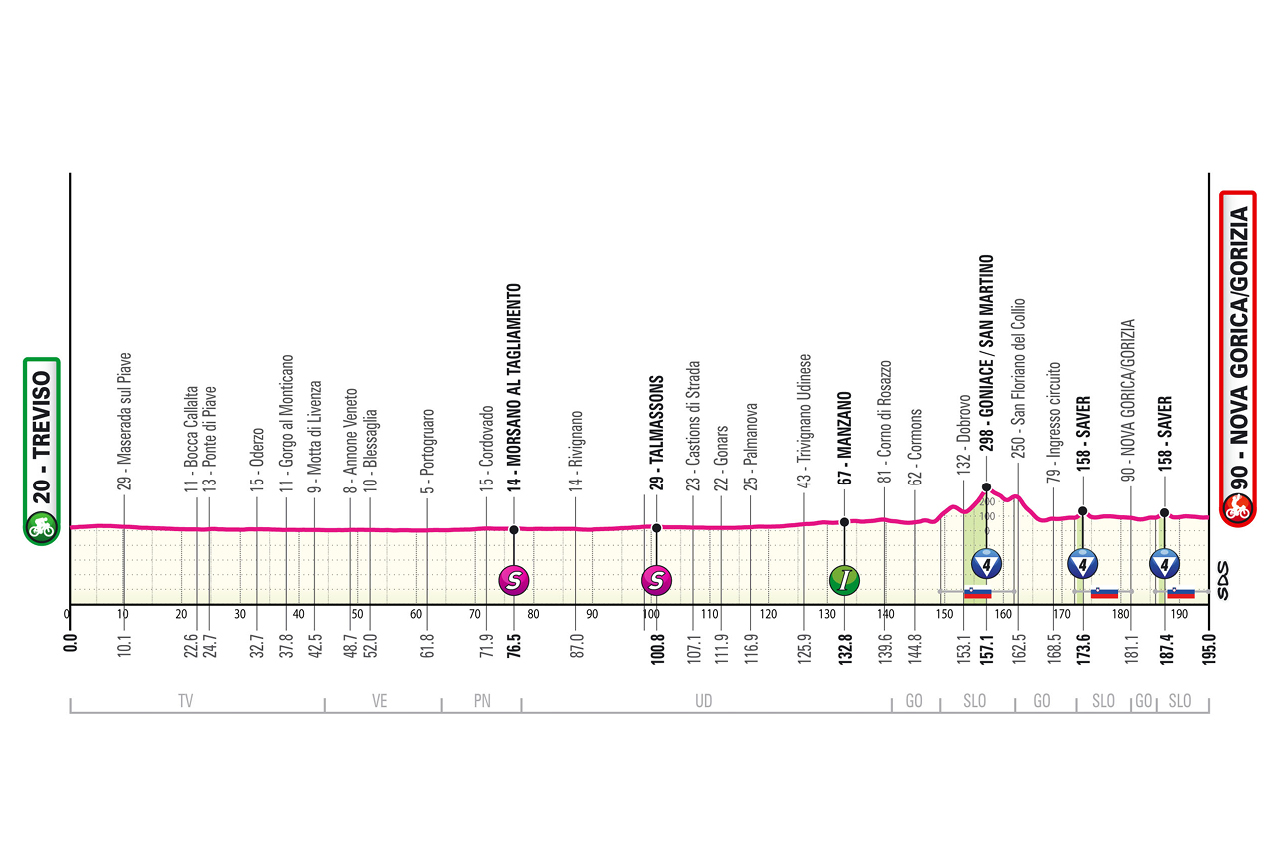
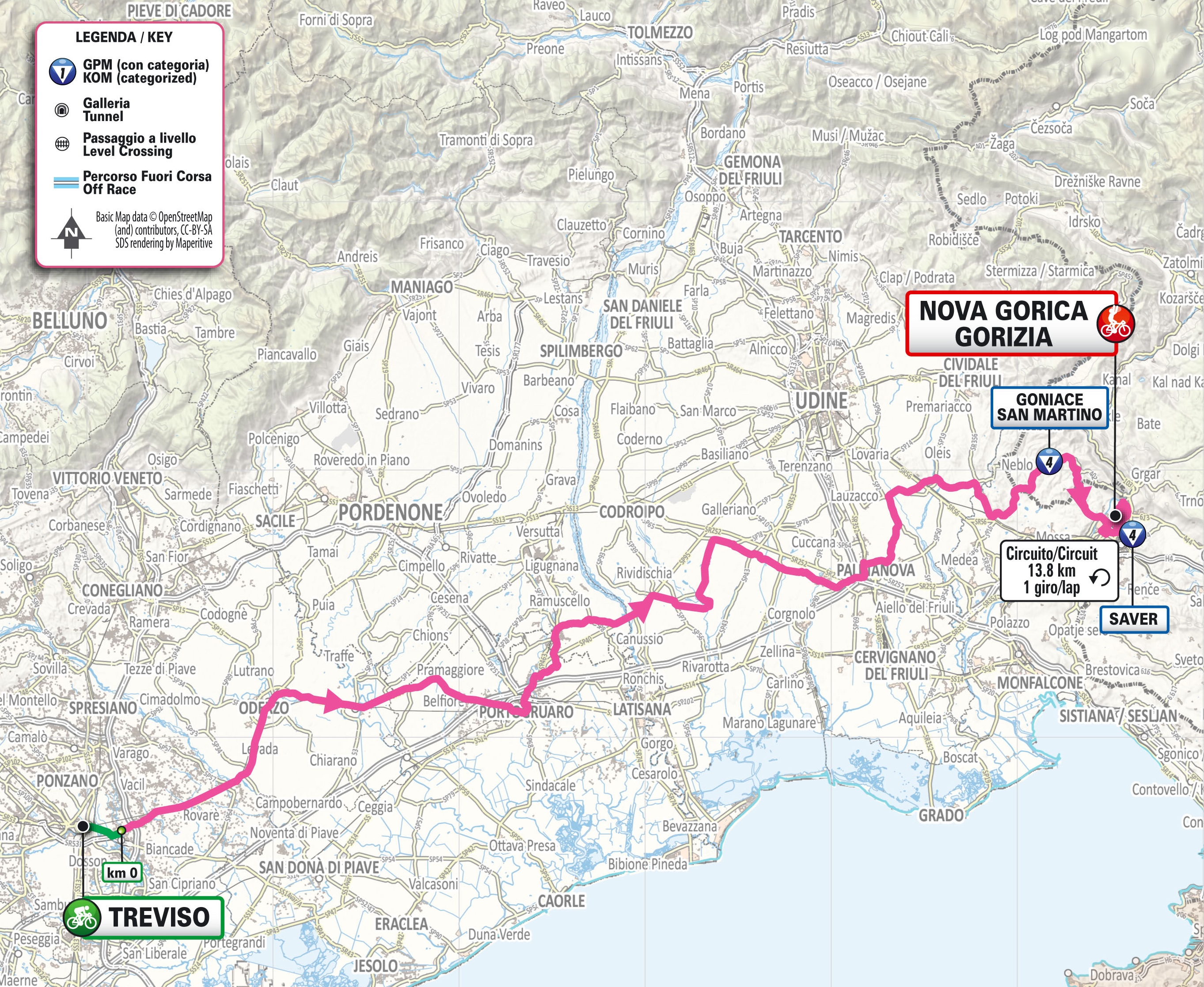
A flat stage through the Veneto plain and southern Friuli awaits on stage 14. Starting in Treviso, the route remains inland for the entirety of 186km, taking in a section of neighboring Slovenia. There are ups and downs of Collio then two laps of a 13.8km circuit linking the two cities of Nova Gorica and Gorizia. Each lap includes pases over a small KOM at Saver, which after the second pass launches riders for the final 8.5km.
2025 Giro d'Italia stage 14 details
Stage 15: Fume Veneto - Asiago (214km)
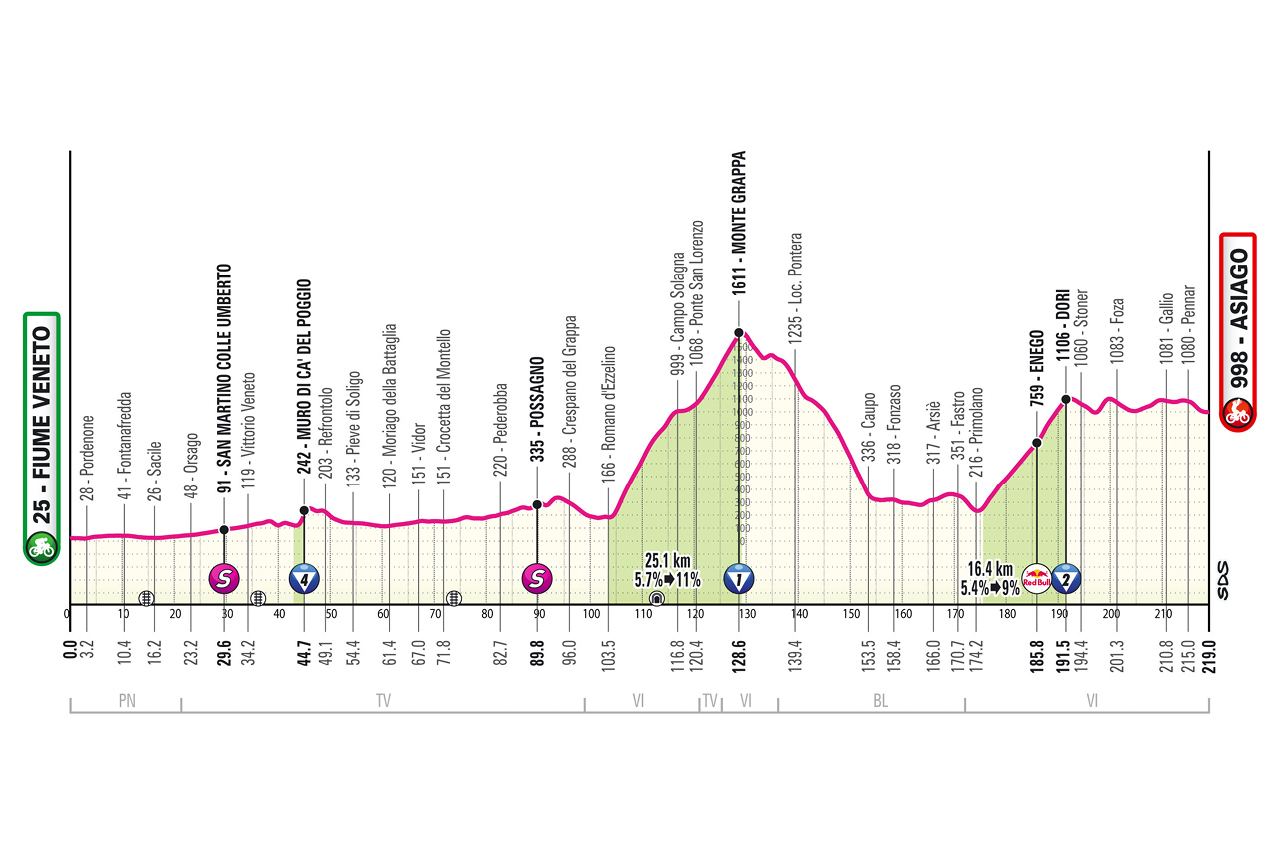
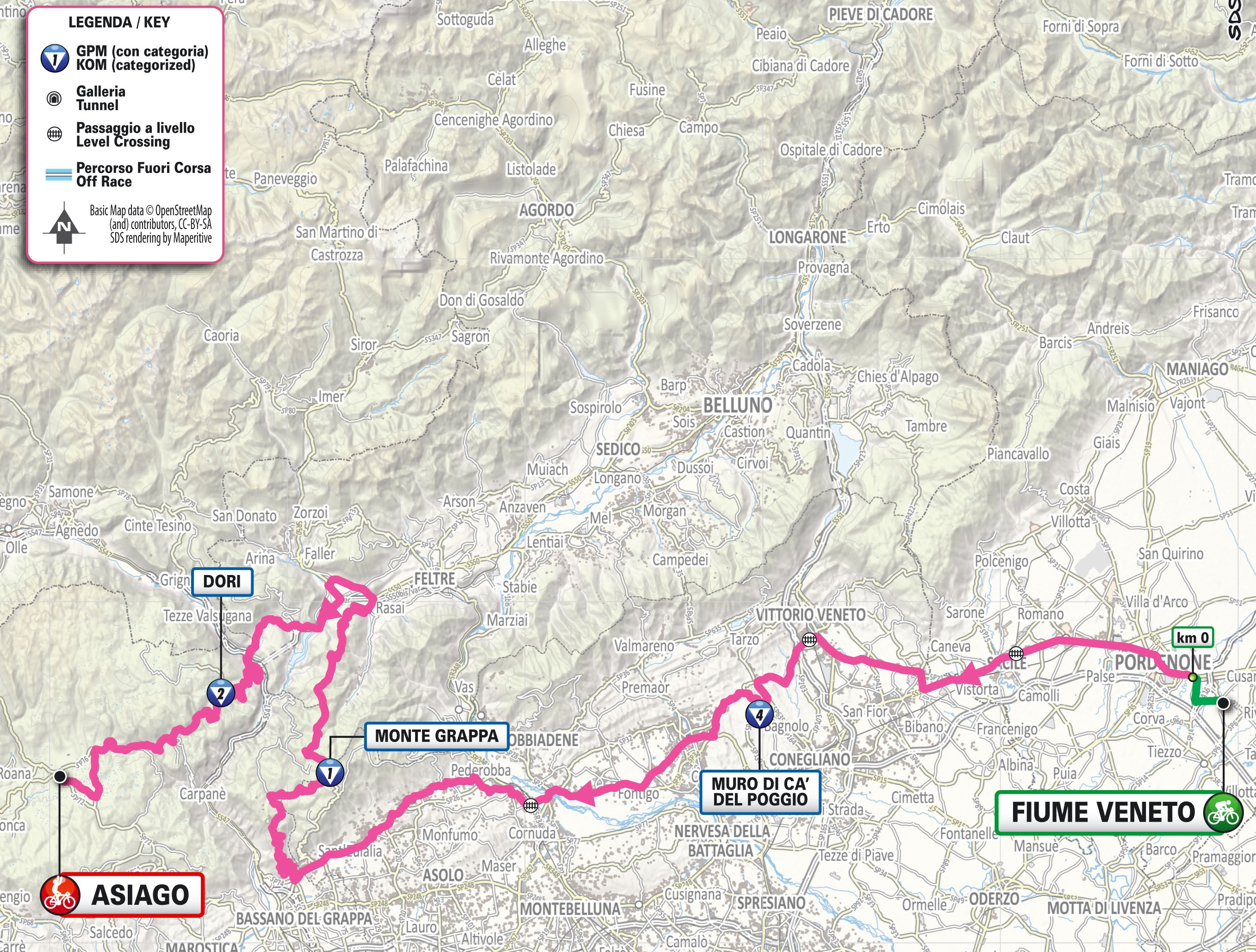
Major mountains return to the menu on Sunday, May 25, as stage 15 serves 3,900 metres of elevation gain across 214km. From Fume Veneto, the route clips along for 42km to pass the Muro di Ca' del Poggio KOM and then begins the 43km approach to the mid-race monster, Monte Grappa (25km at 5.7%), tackled from a traditional downhill side from the Strada Cadorna. A descent to Feltre leads to the Dori ascent (16.6km at 5.3%) from Enego, and leaves 31km to Asiago.
2025 Giro d'Italia stage 15 details
Stage 16: Piazzola Sul Brenta - San Valentino (199km)
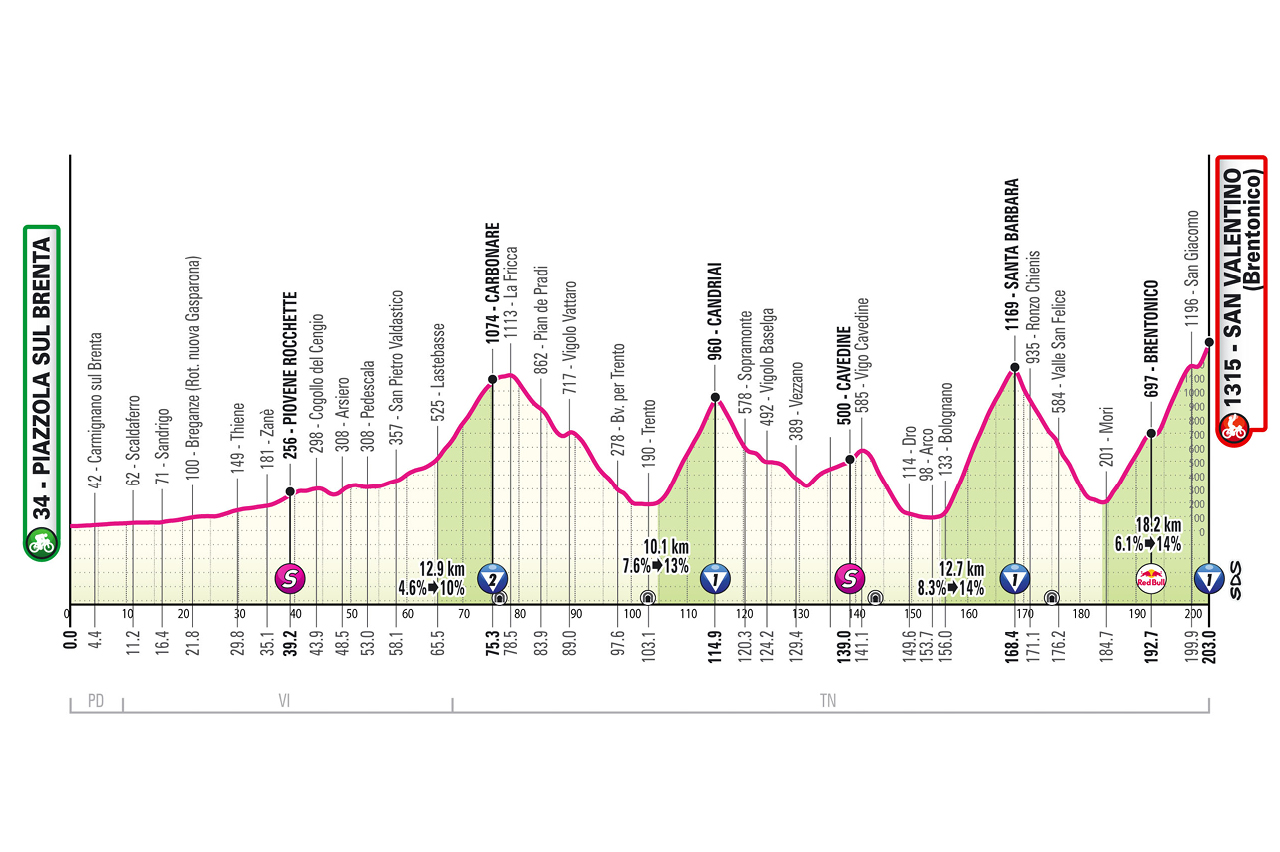
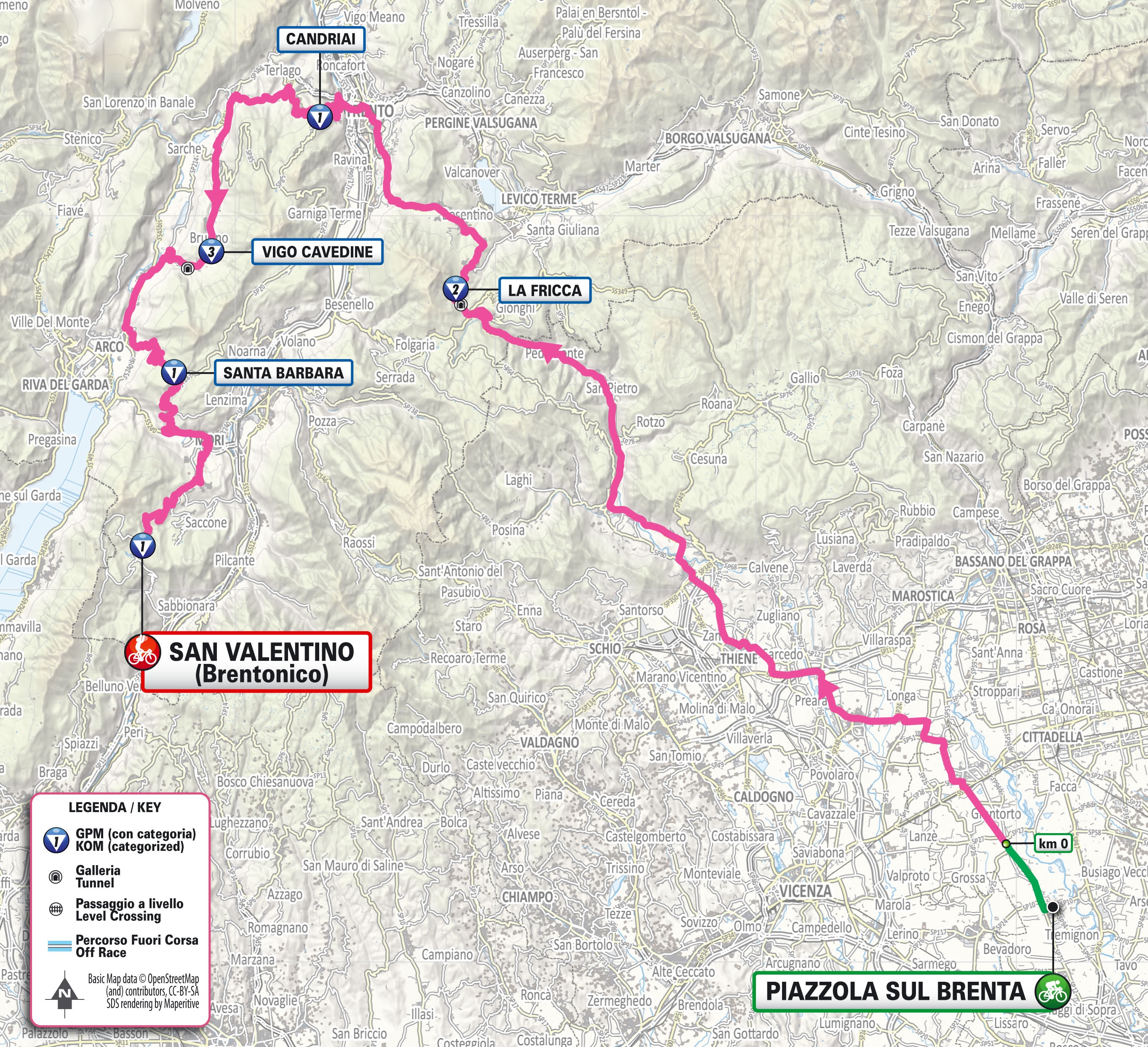
The third and final rest day on Monday, May 26 sets up five consecutive days in the high mountains for a showdown in Rome on June 1.
Five of the final six stages are in the high mountains as the Giro crosses from the Veneto region in the east to the Alps in the west, via Bormio and the Valtellina area close to Switzerland.
There's no gradual entry for the climbing as stage 16 delivers five classified climbs for 4,900 metres of elevation gain across nearly 200km. From Villa Contarini in Piazzola sul Brenta, the route enters Trentino from the Val d'Astico. La Fricca (13km at 4.3%) begins a series of climbs and ascents, followed by Candriai 10.3km at 7.3%), Vigo Cavedine (9.1km at 2.7%), Santa Barbara (12.8km at 8.3%) and the final ascent on Brentonico (17.5km at 6.3%) to the mountaintop finish at San Valentino.
2025 Giro d'Italia stage 16 details
Stage 17: San Michele all'Adige - Bormio (154km)
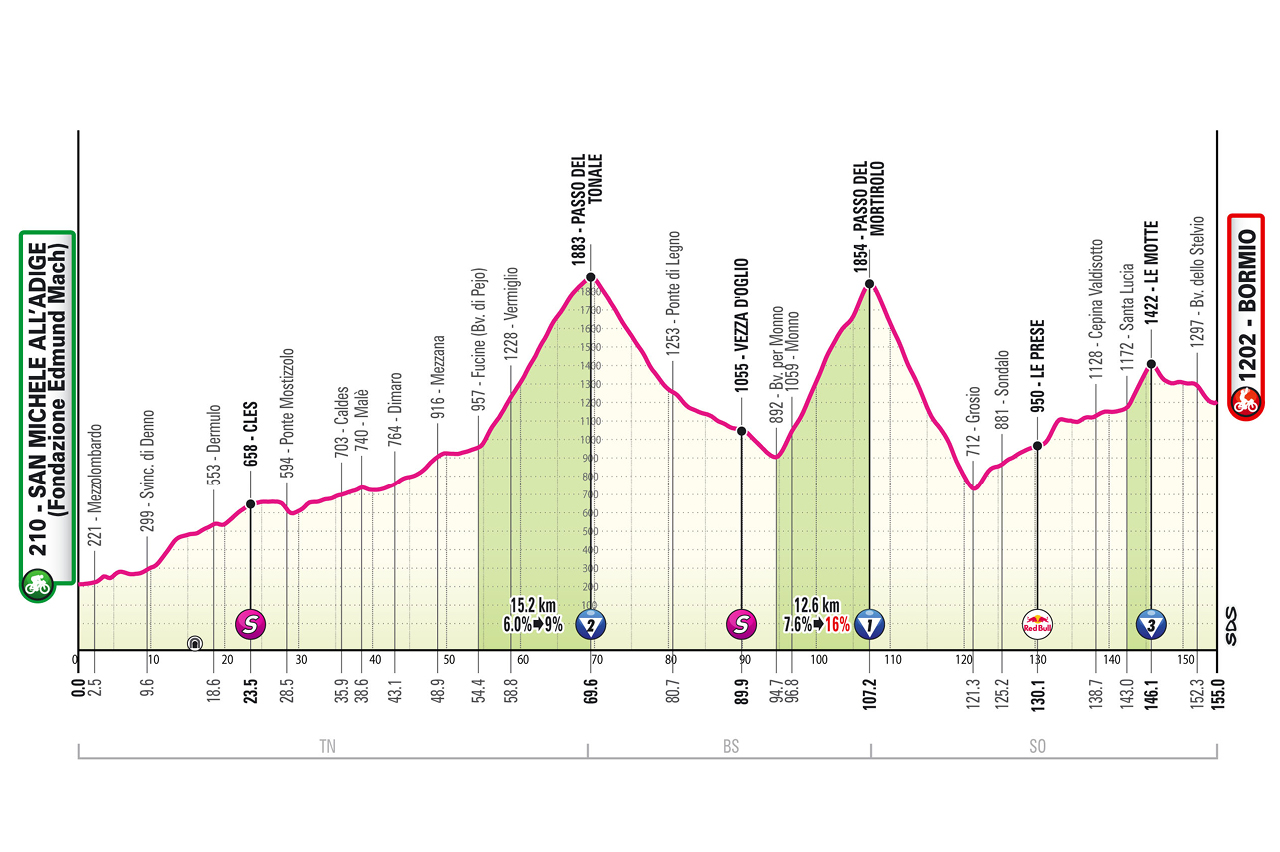
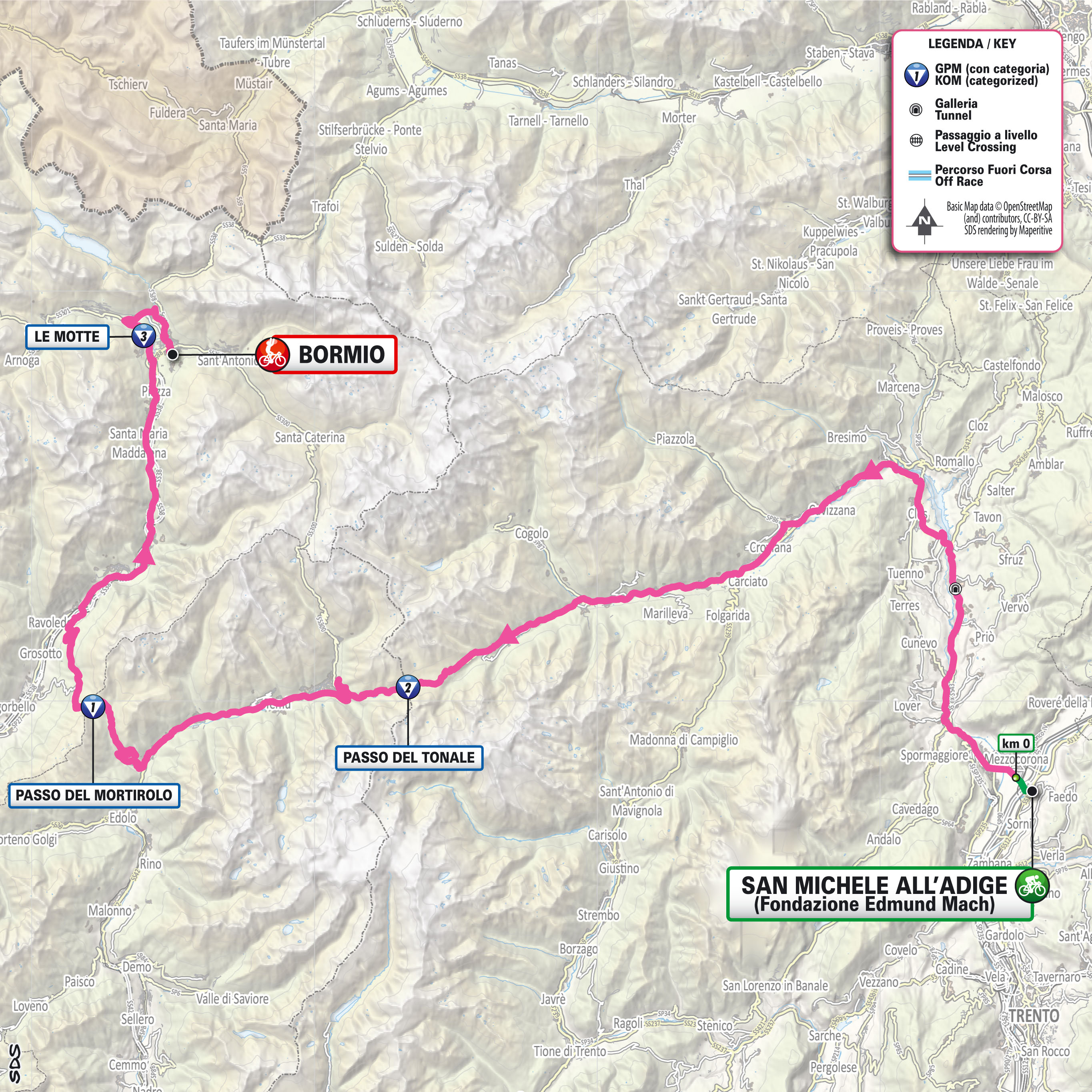
The mighty Mortirolo follows the Passo del Tonale for a one-two punch in the middle of stage 17, this 154km route likely to create gaps in the GC. From San Michel all'Adige, the route heads north-west to the heart of the Alta Valtellina of the Italian Alpes near Switzerland. At kilometre 48.5, the 15.1km ascent of the Tonale (6.1% average gradient) begins.
A gradual descent leads to the Passo del Mortirolo (12.7km at 7.6%), climbed from the easier side from Monno but still a challenge with the average kicking to 9.6% on the final three kilometres. Once at the bottom of the pass, it is a rolling 33.5km remaining, with a category 3 KOM at Le Motte (3.2km at 7.9%) to the arrival in Bormio.
2025 Giro d'Italia stage 17 details
Stage 18: Morbegno - Cesano Maderno (144km)
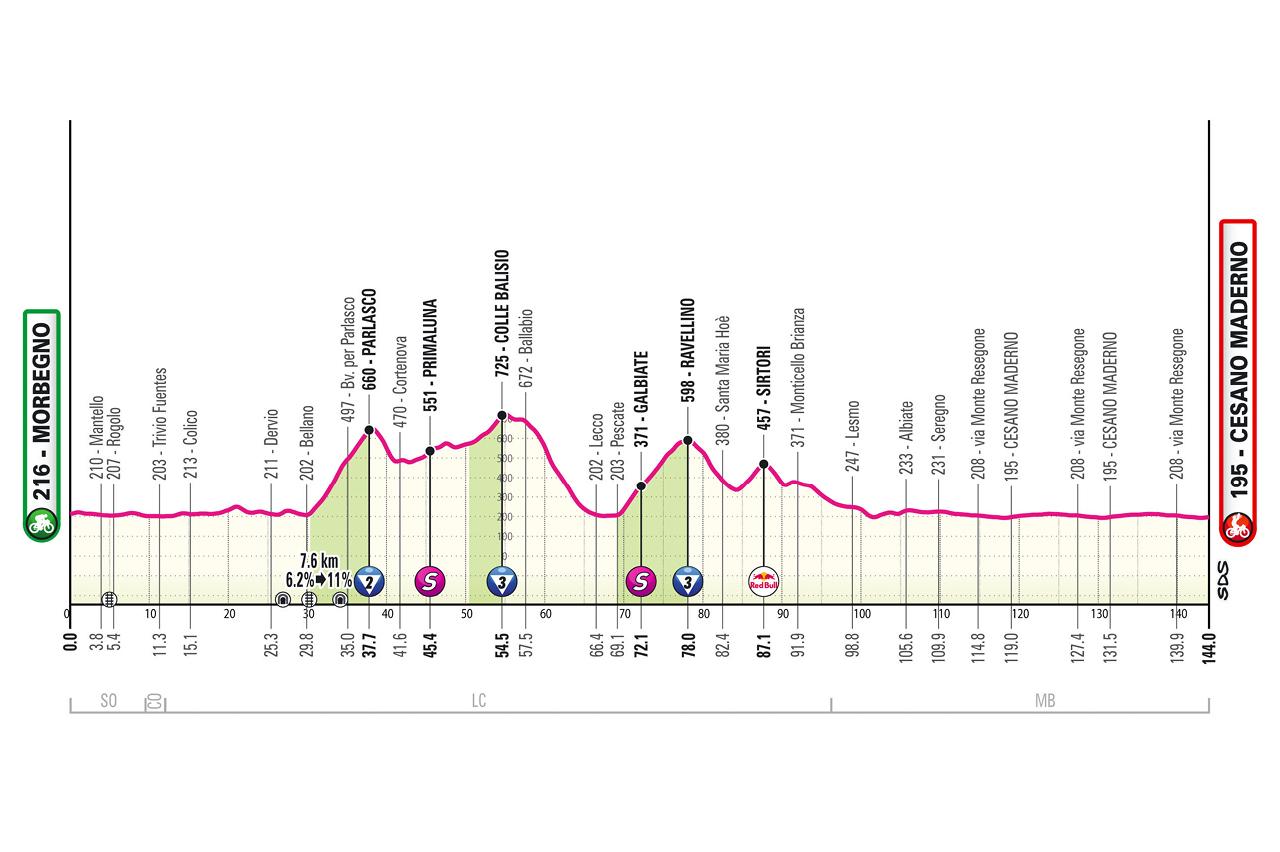
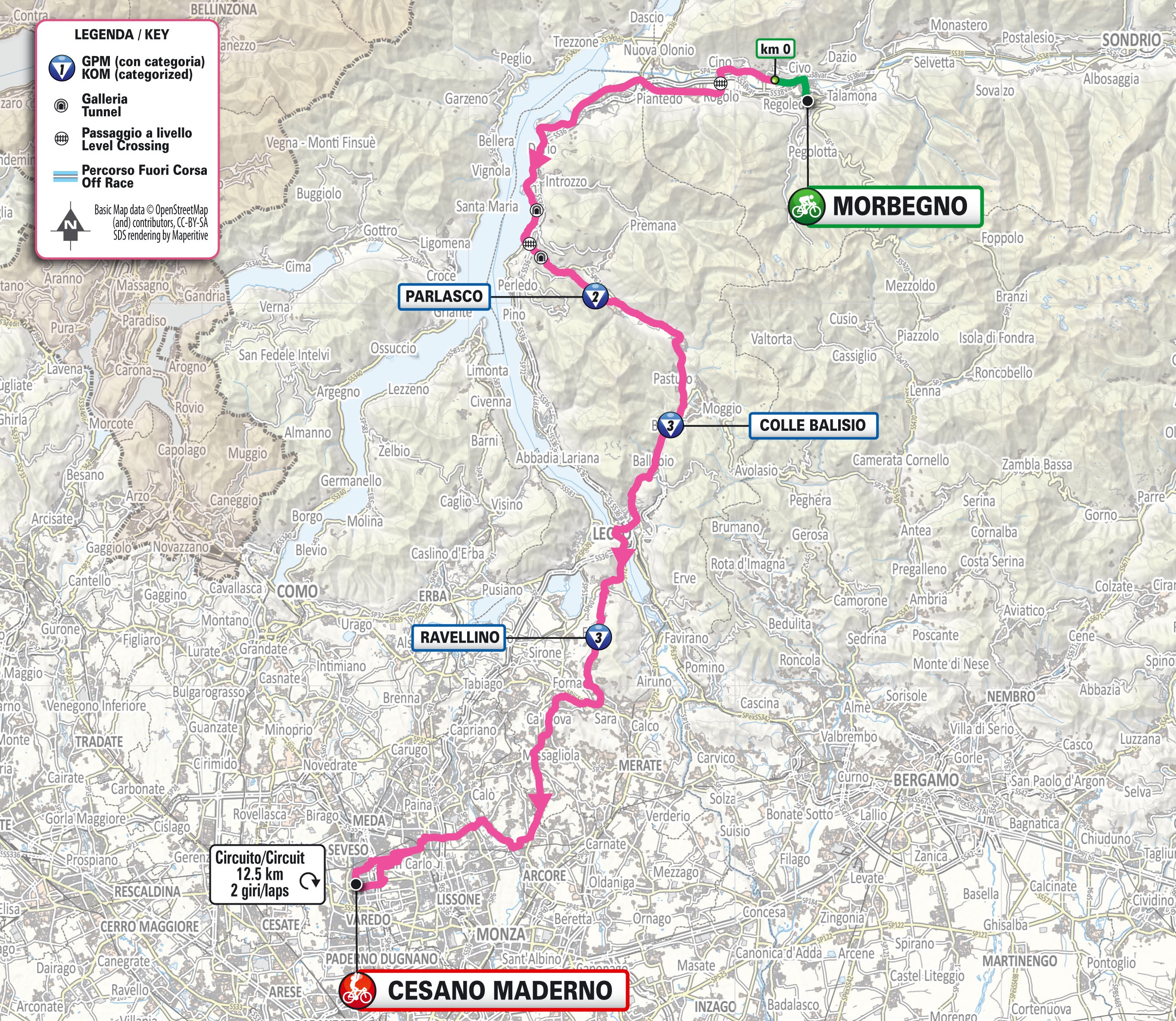
Opportunities abound on stage 18 as the Giro heads west via Cesano Maderno near Milan. From a flat start in Morbegno, breakaway riders look to extend their margins for a series of three classified climbs between kilometre 29.5 and 78. In that stretch are Parlasco (7.7km at 5.8%), Colle di Balisio (4.7km at 3.4%) and Ravellino (8.7km at 4.4%). The after an uncategorised climb at Sirtori, more flat terrain unfolds for 57.5km into Cesano Maderno where two 12.5km finishing laps decide if a break stays away.
2025 Giro d'Italia stage 18 details
Stage 19: Biella - Champoluc (166km)
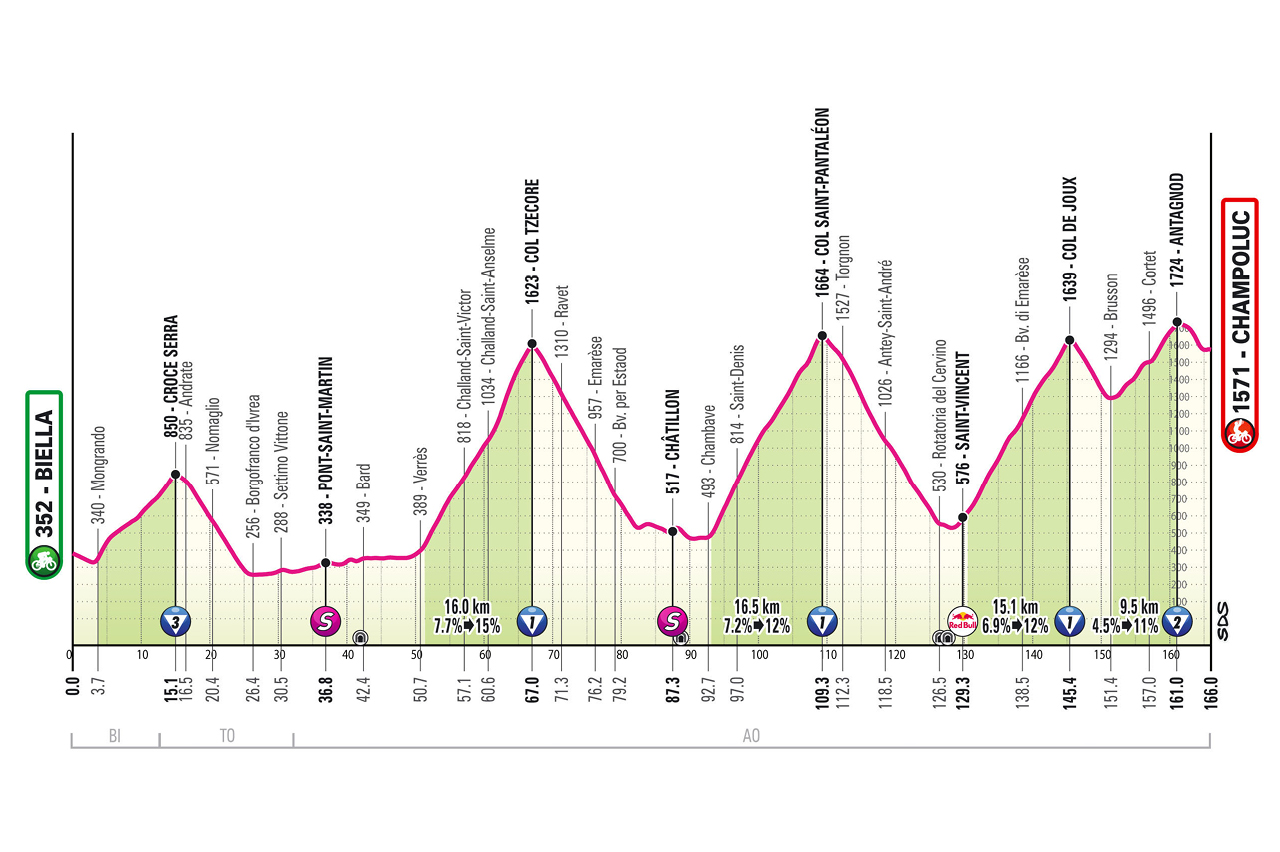
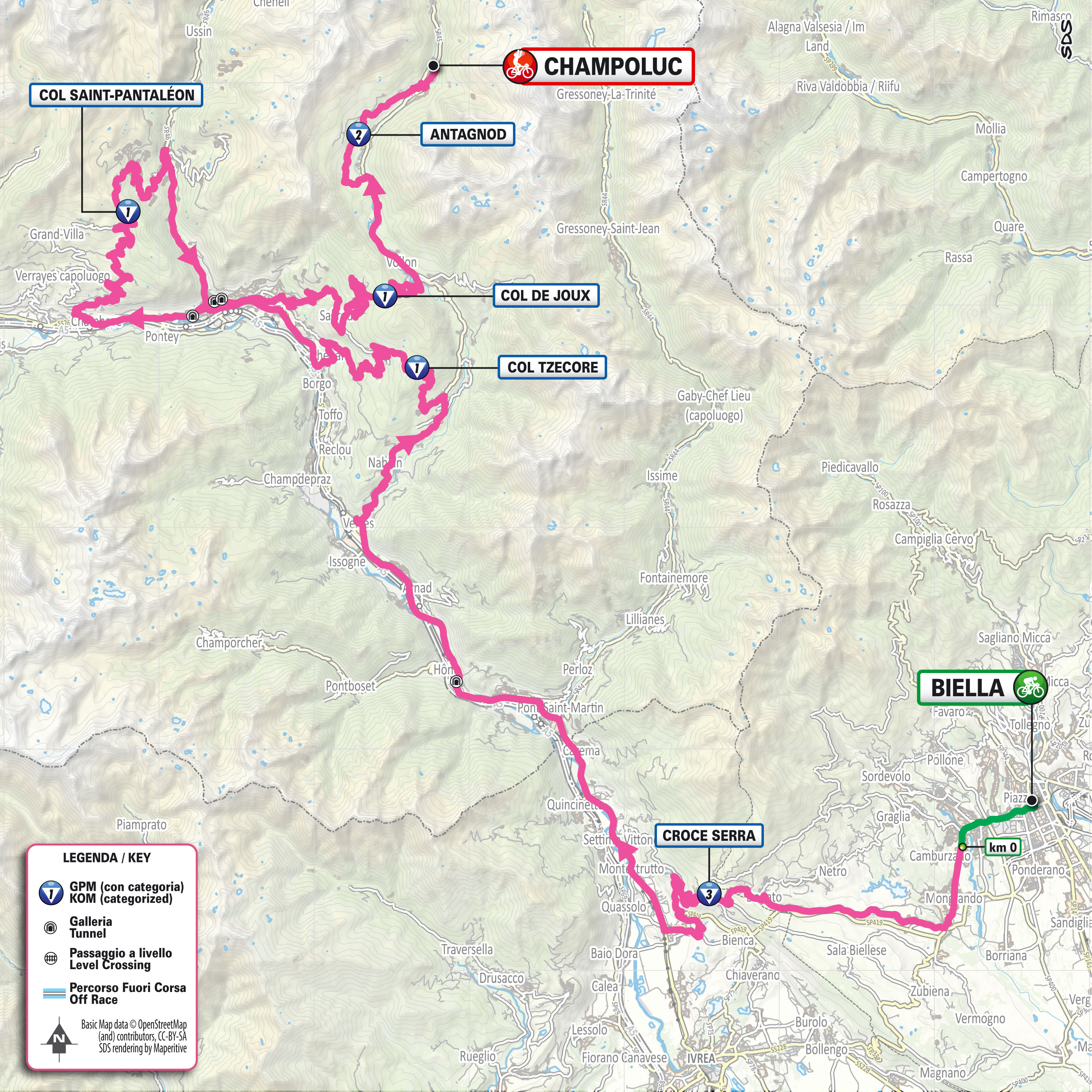
Friday showcases a high mountain stage that soars into the Val d'Aosta and includes 4,950 metres of elevation gain across 166km. Stage 19 includes five major climbs, with descending a major skill needed as well to complete the journey from Biella to Champoluc.
After climbing immediately at Croce Sera (11.5km at 4.5%) and traversing 25km in the Dora Baltea valley, three successive category 1 ascents will hit the legs hard, each ranging in similar distances from 15 to 16km, then leaving just 20km to race. Col Tzecore is first with an average of 7.5% gradient, then Col Saint-Pantaléon at 7.3% average and Col de Joux at 6.8% average. A short descent leads to Brusson, followed by the final climb to Antagnod (9.6km at 4.5%) that leaves 5km to the finish.
2025 Giro d'Italia stage 19 details
Stage 20: Verrès - Sestrière, via Lattea (203km)
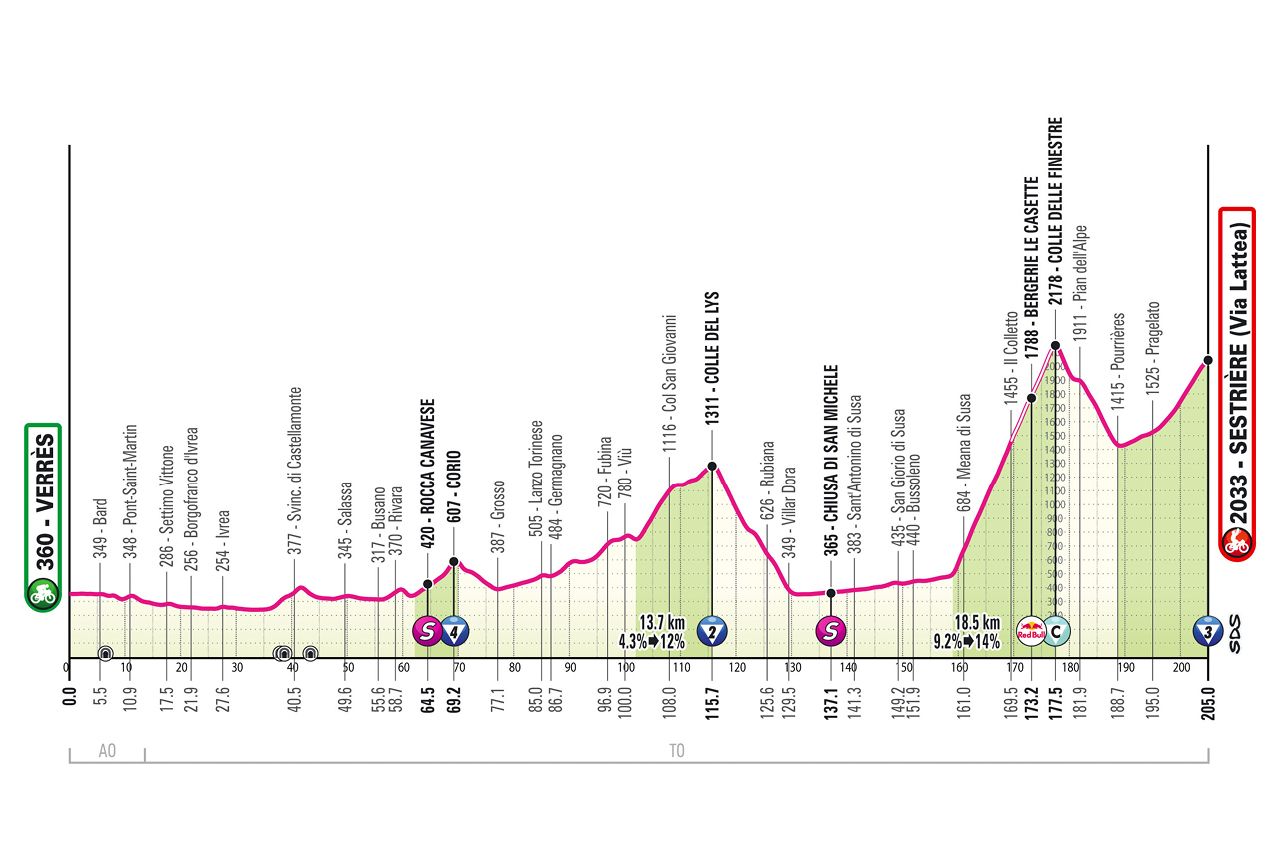
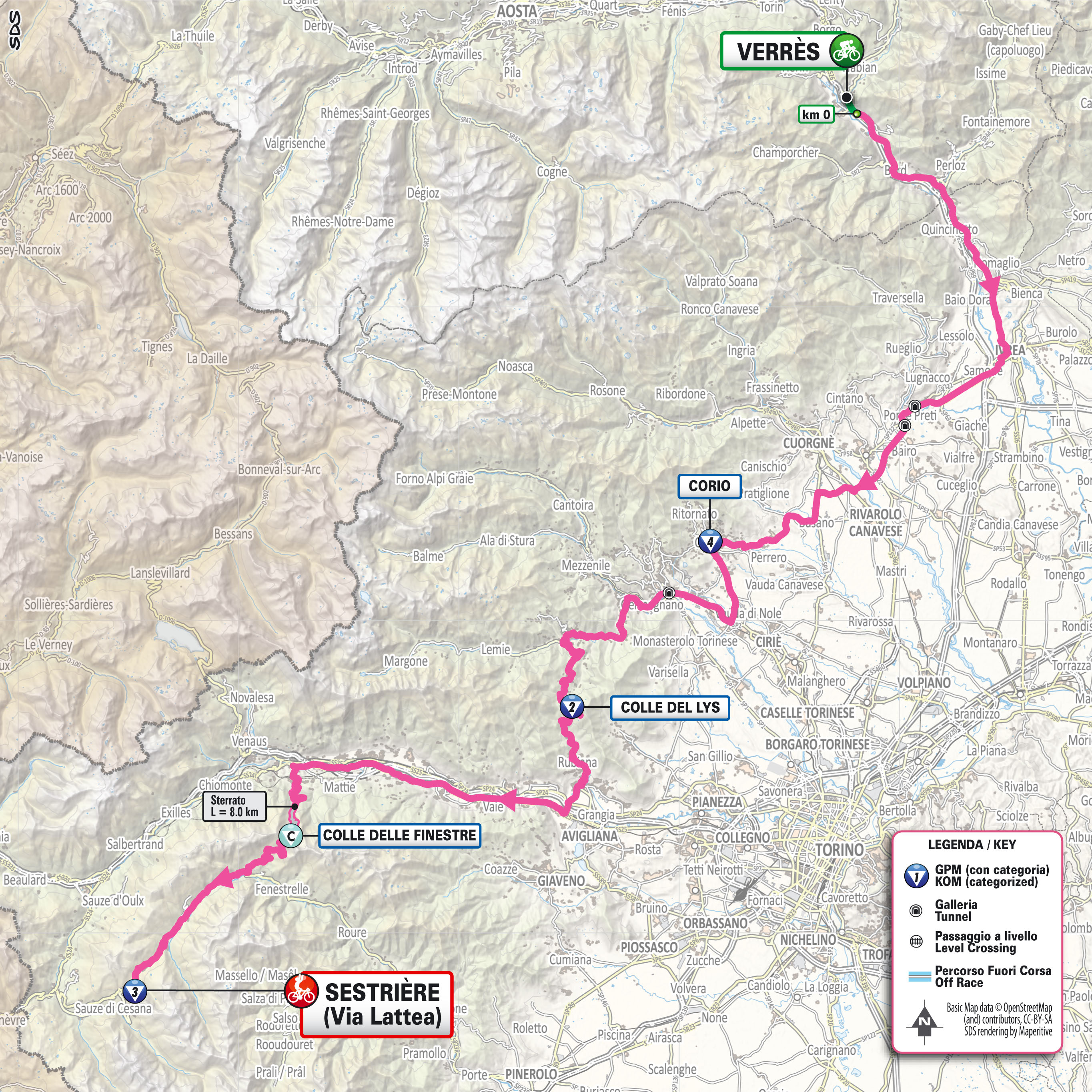
A final showdown in the mountains on the penultimate day of racing is similar to Friday, with four categorised climbs and an additional 37 kilometres for 203km total. It's a rolling start from Verrès as the category 4 Corlo (4.3km at 4.2%) signals bigger hills.
With 100km covered, the 13.6km climb to Colle del Lys (average of 4.2%) indicates attack time to the Colle delle Finestre, the highest climb of the 2025 Giro and this year's Cima Coppi. There is also 8km of gravel on a 9% gradient. After a brief descent, the final 17.7km push to Sestriere remains.
2025 Giro d'Italia stage 20 details
Stage 21: Rome - Rome (141km)
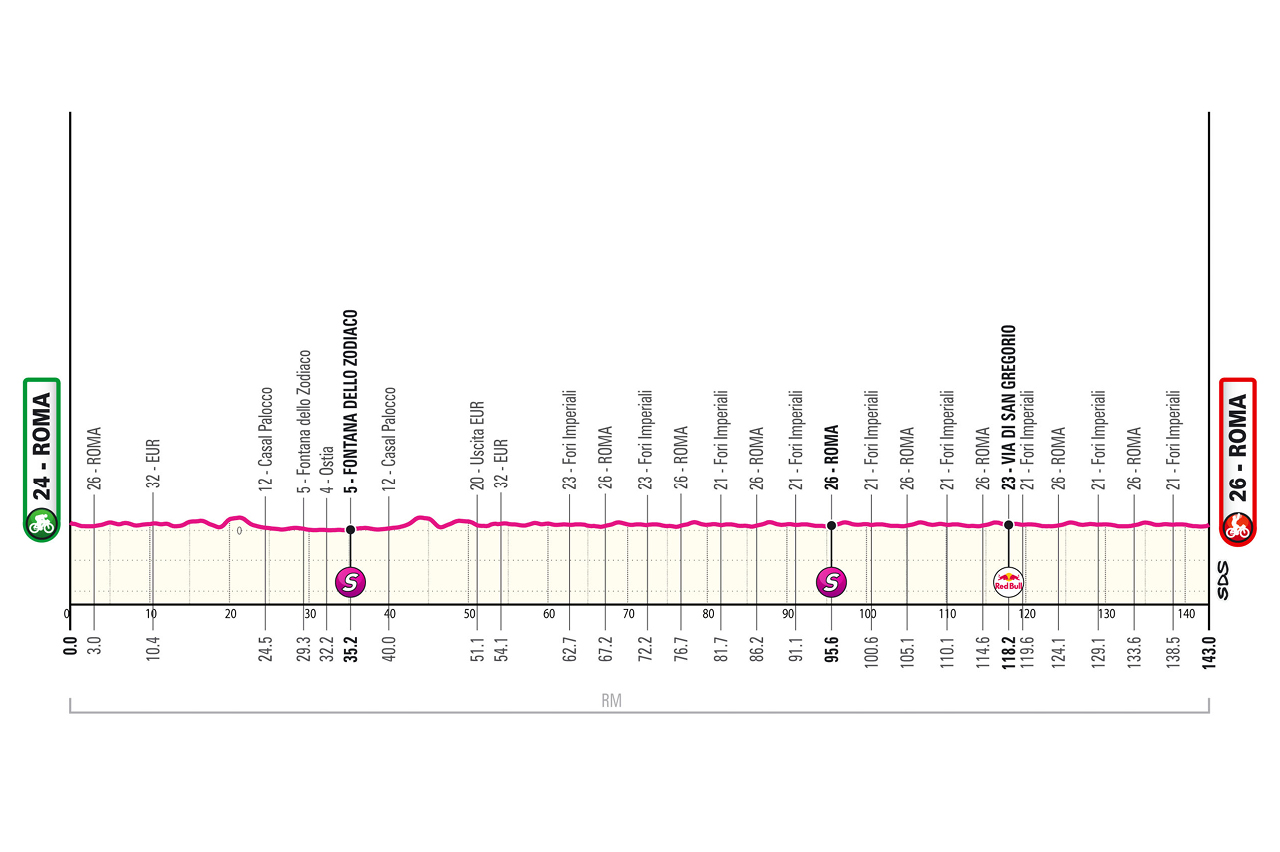
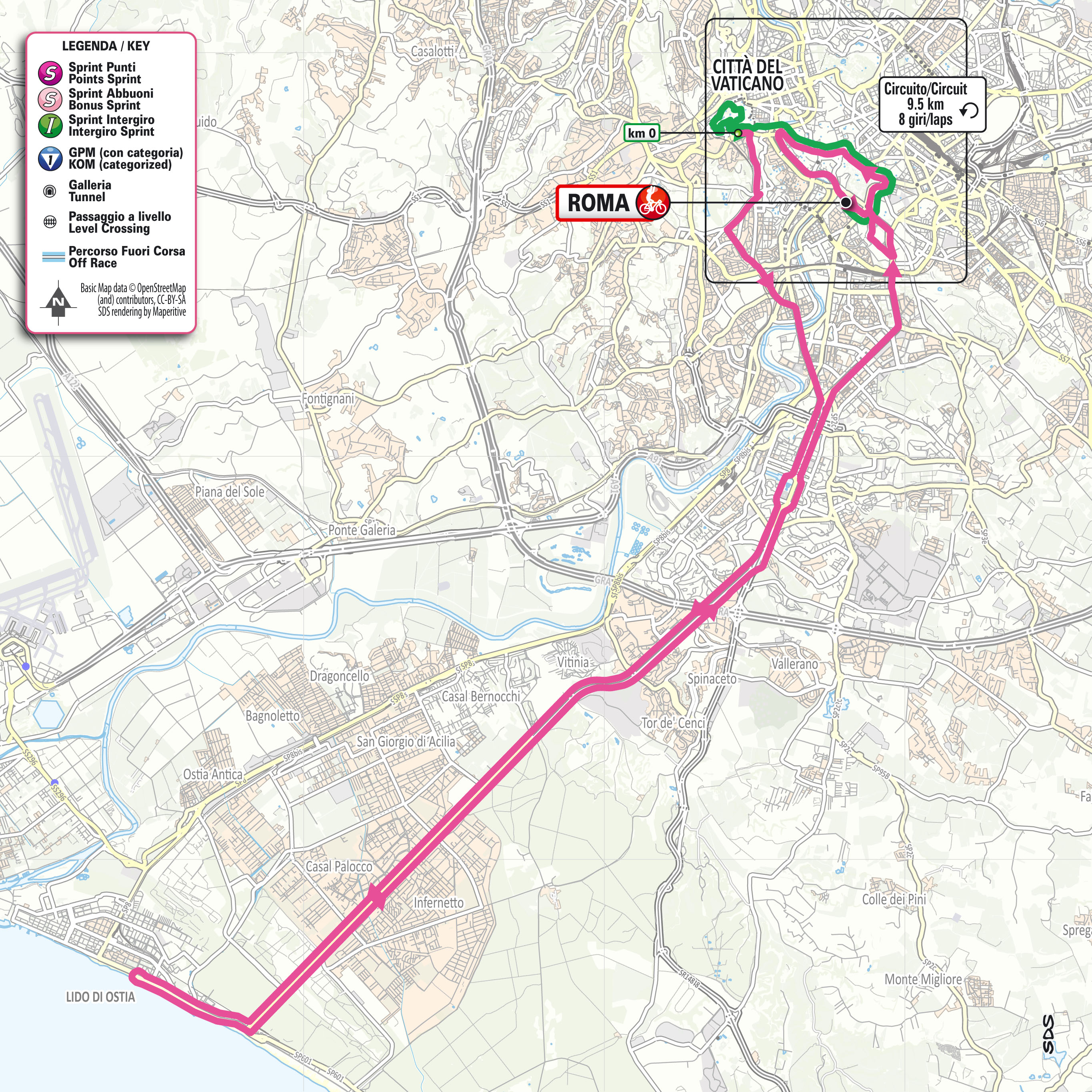
The race caravan will descend to Turin after the stage for a plane or fast train to Rome and the 780km transfer. The recent Rome finishes have been spectacular in the Eternal City but questions remain about the environmental concerns of such a long haul for a final stage.
The winner of the 2025 Giro d'Italia will again be crowned in the shadows of the Colosseum and Roman ruins, with the sprinters given one last shot at victory in the Italian capital.
From Turin on Saturday, the entire race caravan transitions 780km to rome for the finale. Stage 21 is similar to those in past years, featuring an initial back-and-forth to the Tyrrhenian coast at Lido di Ostia followed by eight laps of the 9.5km city circuit.
2025 Giro d'Italia stage 21 details
Subscribe to Cyclingnews for unlimited access to our 2025 Giro d'Italia coverage. Our team on the ground will bring you all the breaking news, reports, analysis and more from every stage of the Italian Grand Tour. Find out more.
The latest race content, interviews, features, reviews and expert buying guides, direct to your inbox!

Stephen is one of the most experienced member of the Cyclingnews team, having reported on professional cycling since 1994. He has been Head of News at Cyclingnews since 2022, before which he held the position of European editor since 2012 and previously worked for Reuters, Shift Active Media, and CyclingWeekly, among other publications.
- Jackie TysonNorth American Production editor
You must confirm your public display name before commenting
Please logout and then login again, you will then be prompted to enter your display name.
Latest on Cyclingnews
-
'I'd opened a B&B, and now I'm national champion' – Why Filippo Conca's spectacular upset win means there will be no Italian tricolore jersey in the pro peloton
Club racer beat former teammates and rivals from pro peloton to clinch biggest victory of his career as Ganna says 'cycling is going to lose a lot' -
Mads Pedersen narrowly avoids disaster in crash with spectator during Danish Time Trial Championships win – Video
29-year-old knocks spectator over after being forced to evade slow police motorcycle during 41km race -
We took 16 pairs of aero socks to the wind tunnel to find which was fastest, and we're still shocked by the results
From Assos and AeroCyclingGear to NoPinz, Rule2, Sockeloen and Velotoze, we tested all the best aero socks on the market to find out whether all aero socks are created equal -
'You don't win a Championships like that' – Remco Evenepoel slams Lotto and other rivals for Belgian Nationals road race tactics
Strongest rider of day has to settle for second, 38 seconds down behind lone winner Tim Wellens

